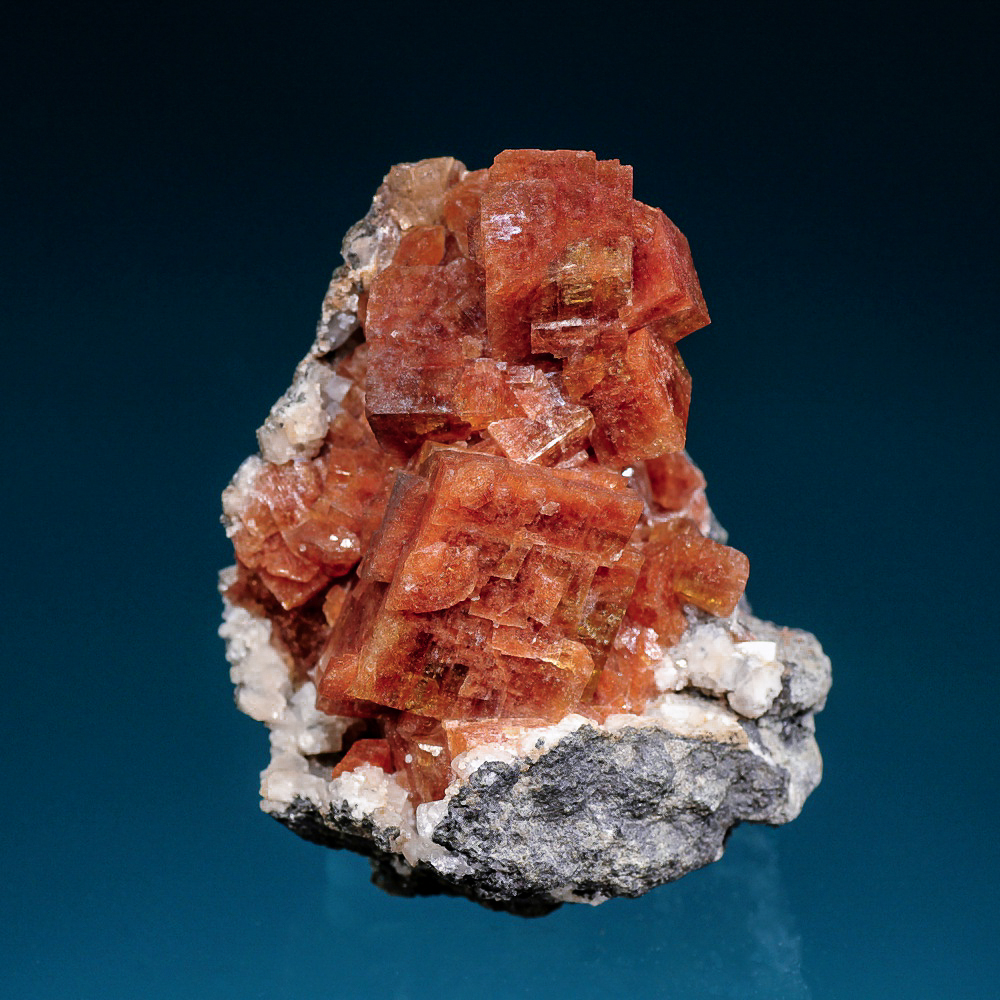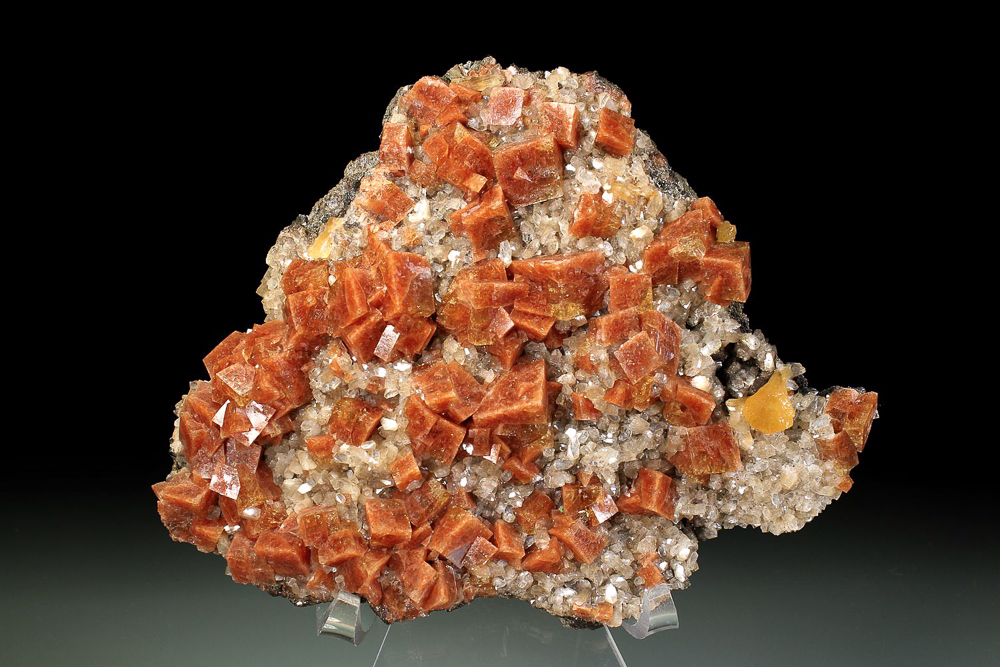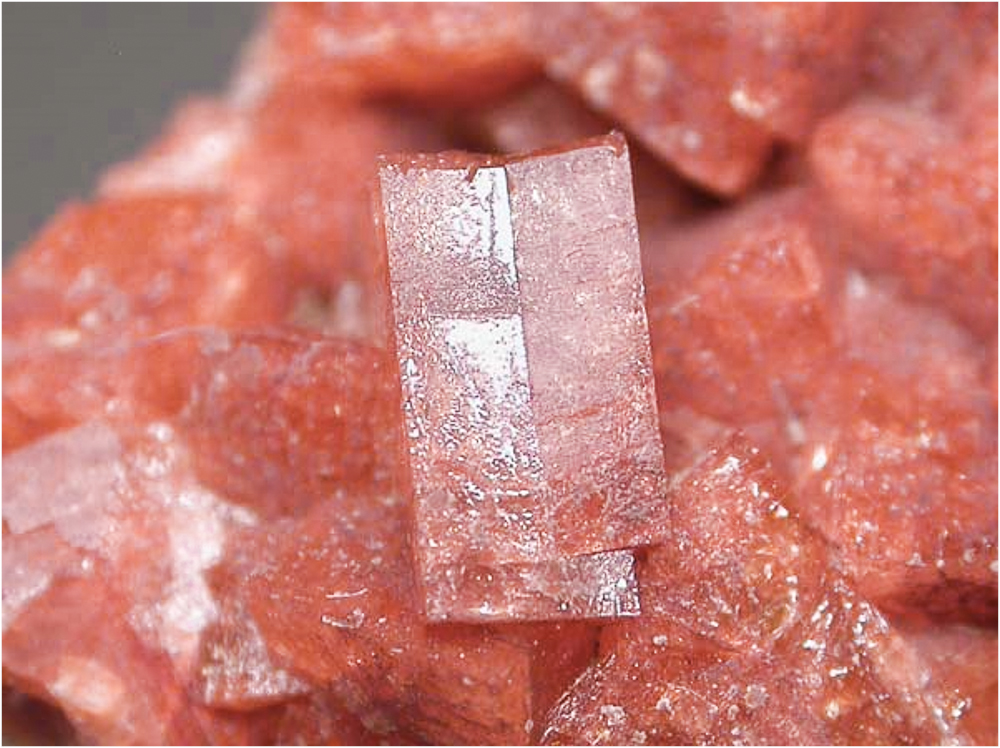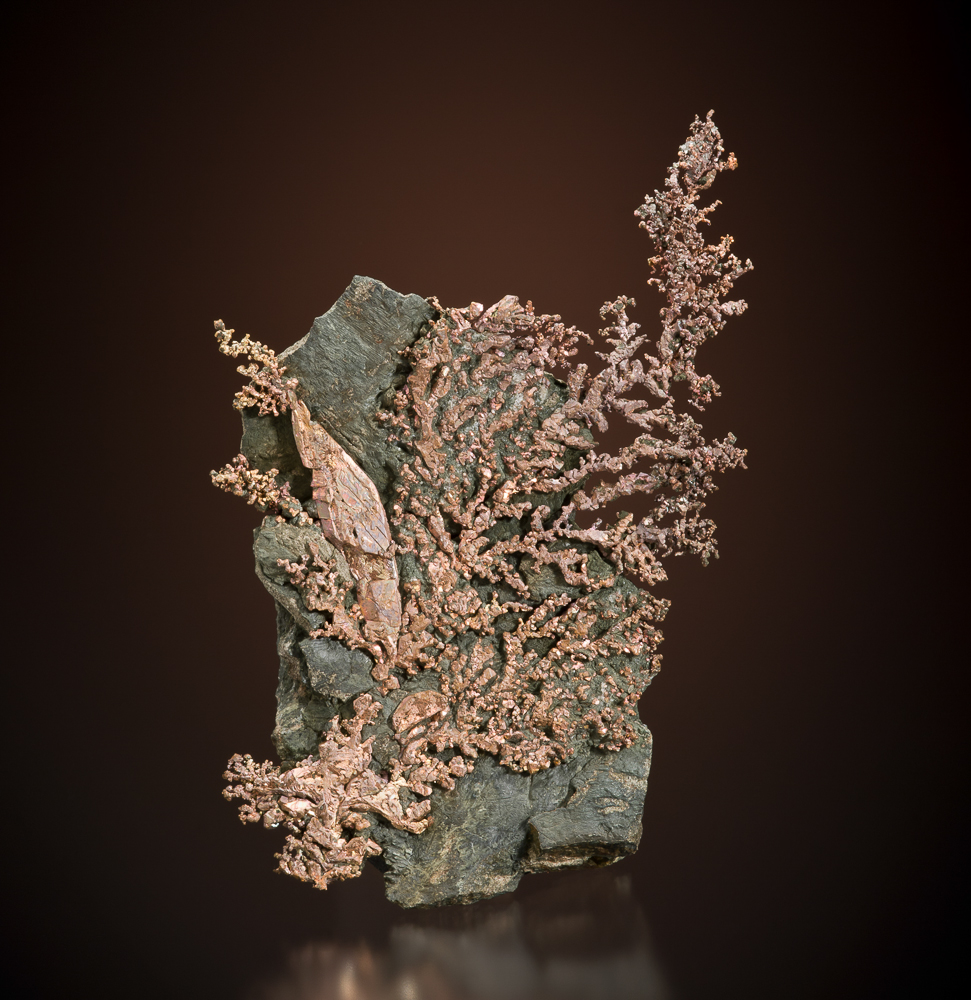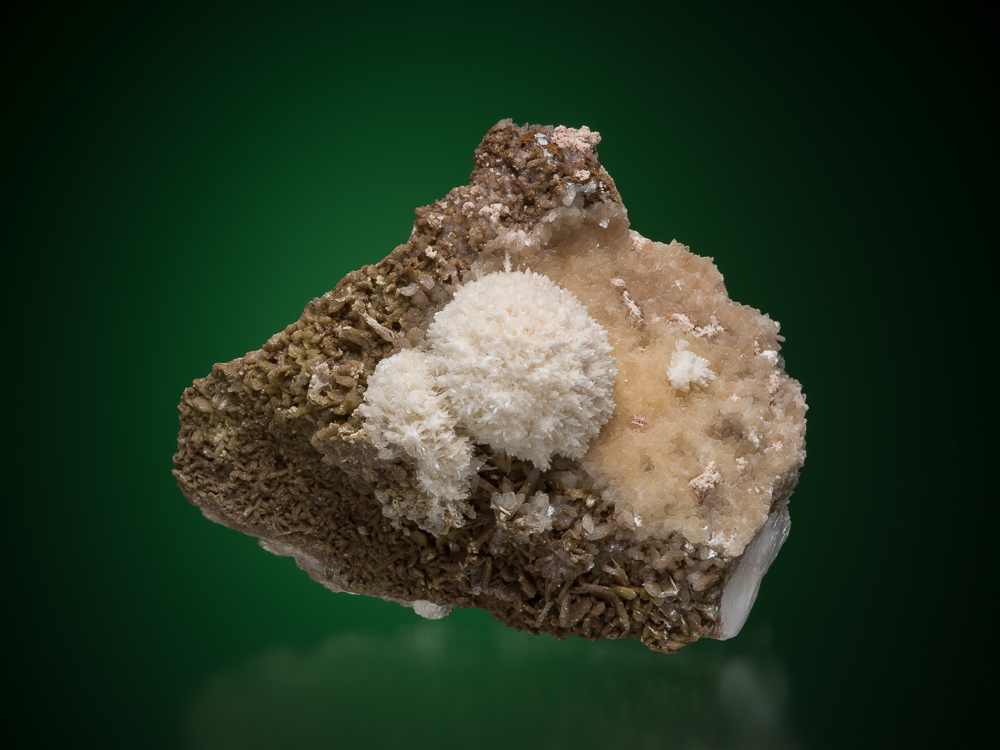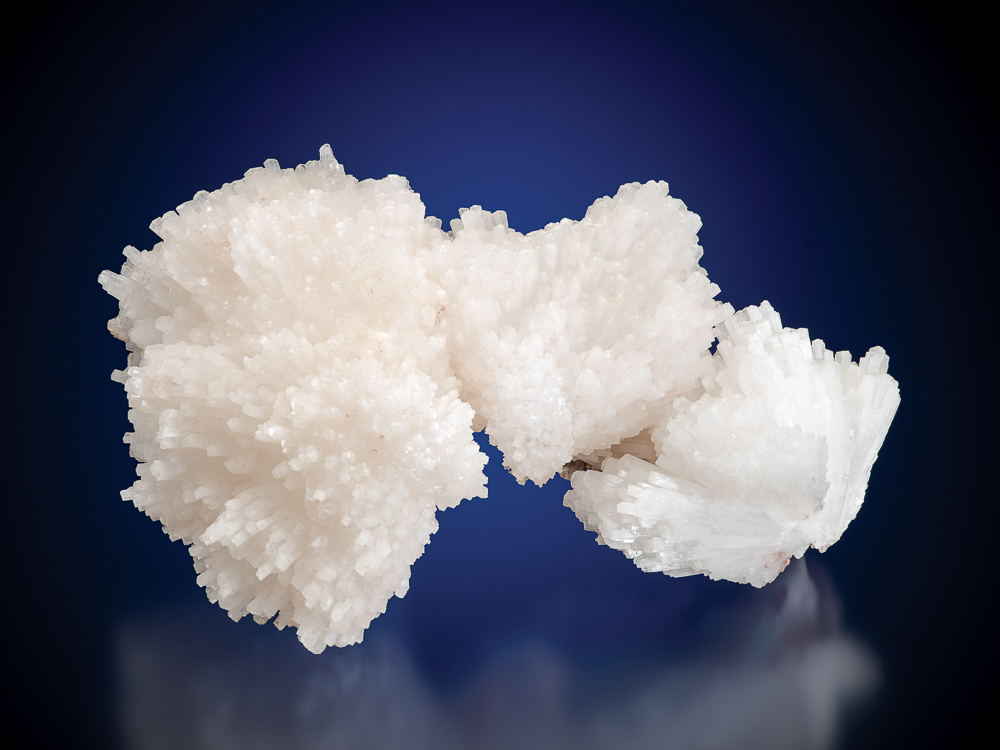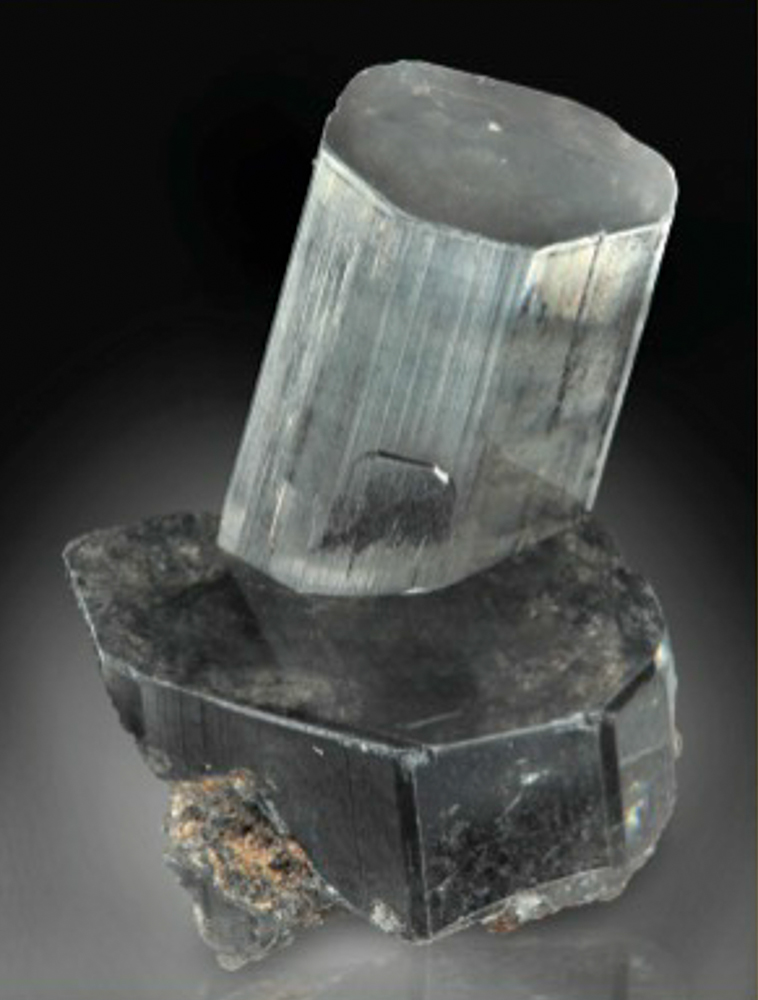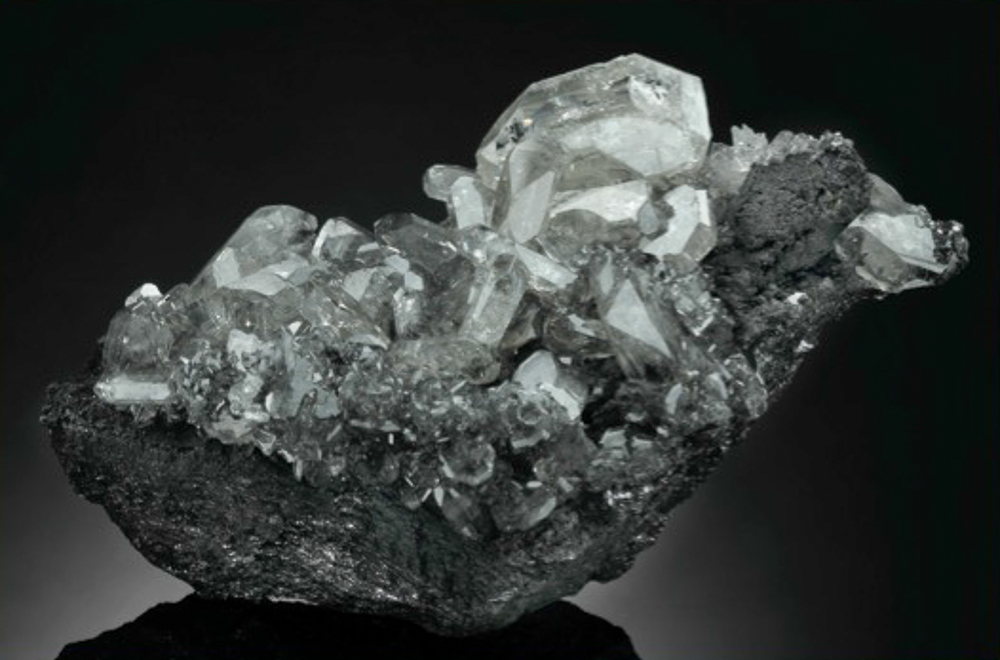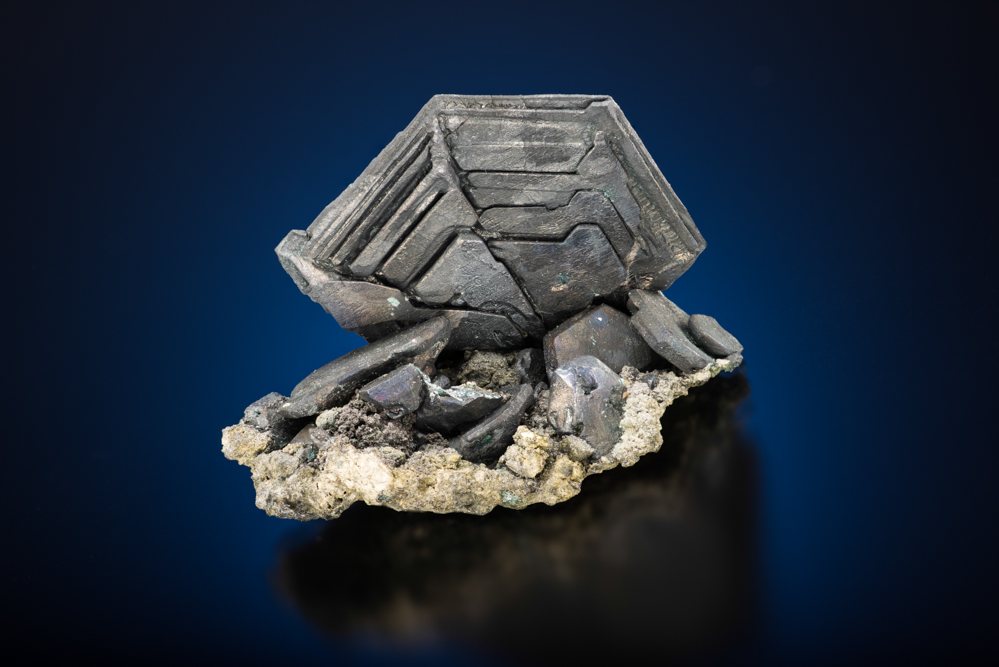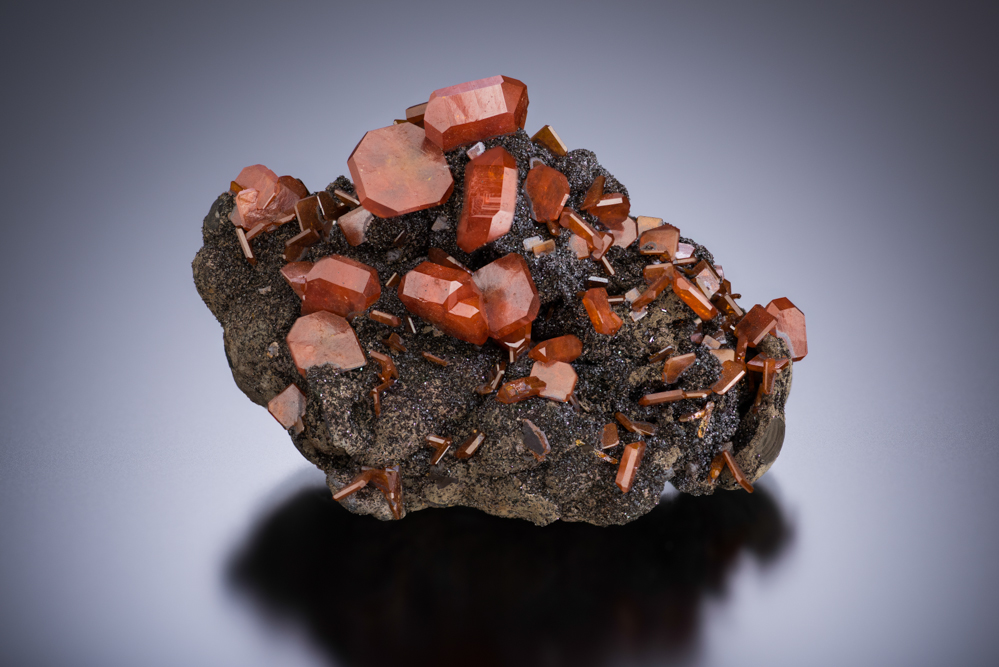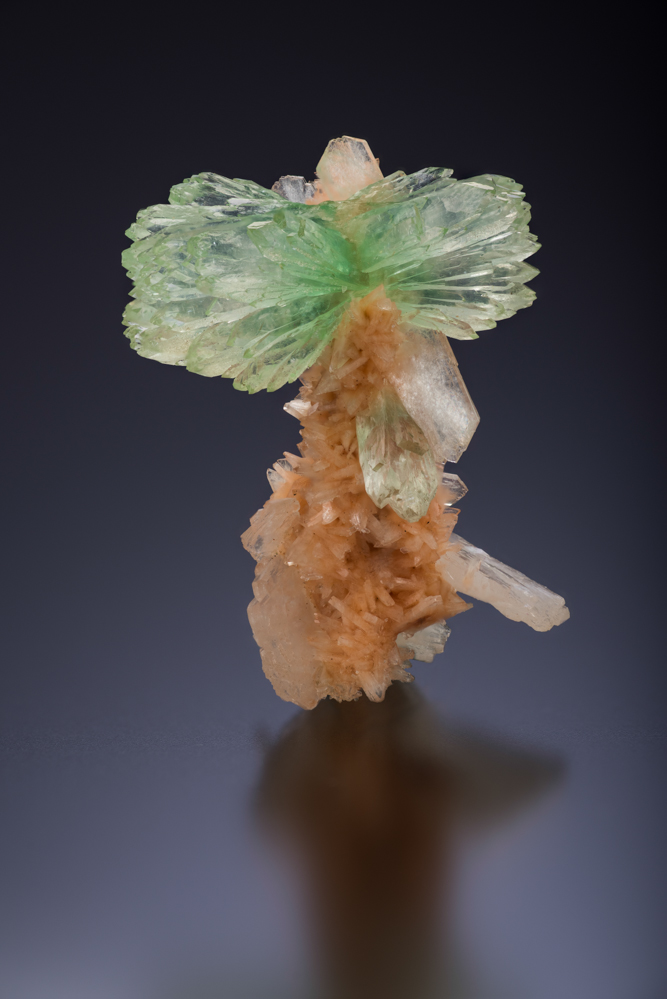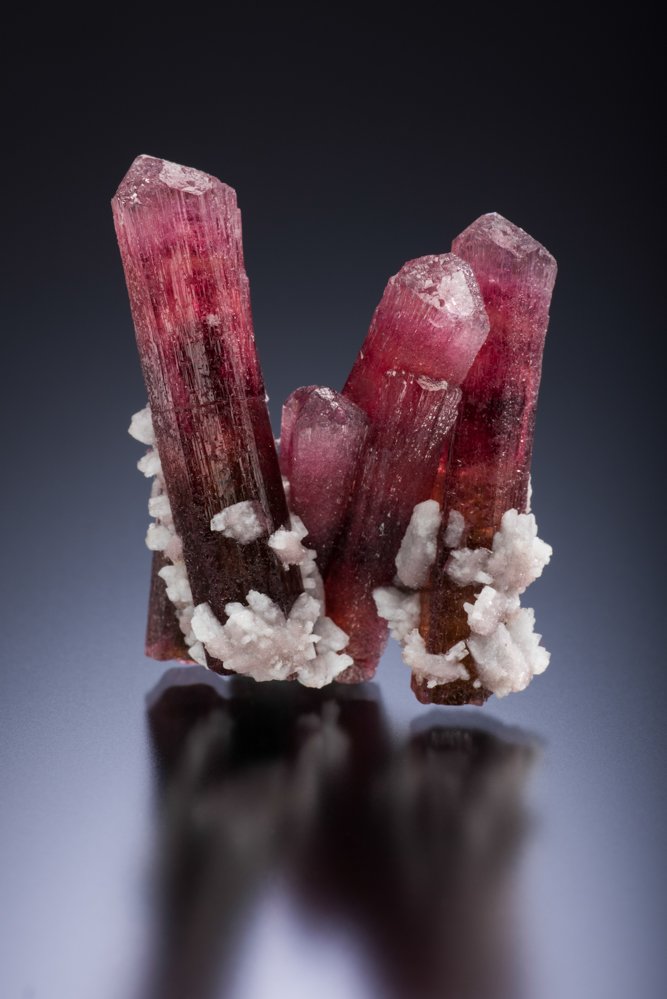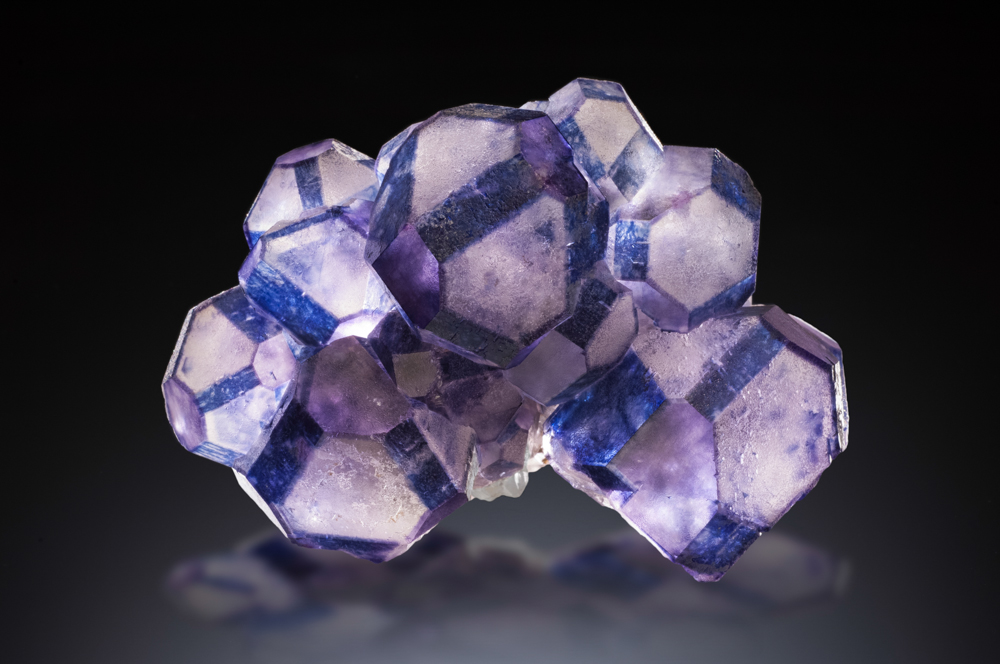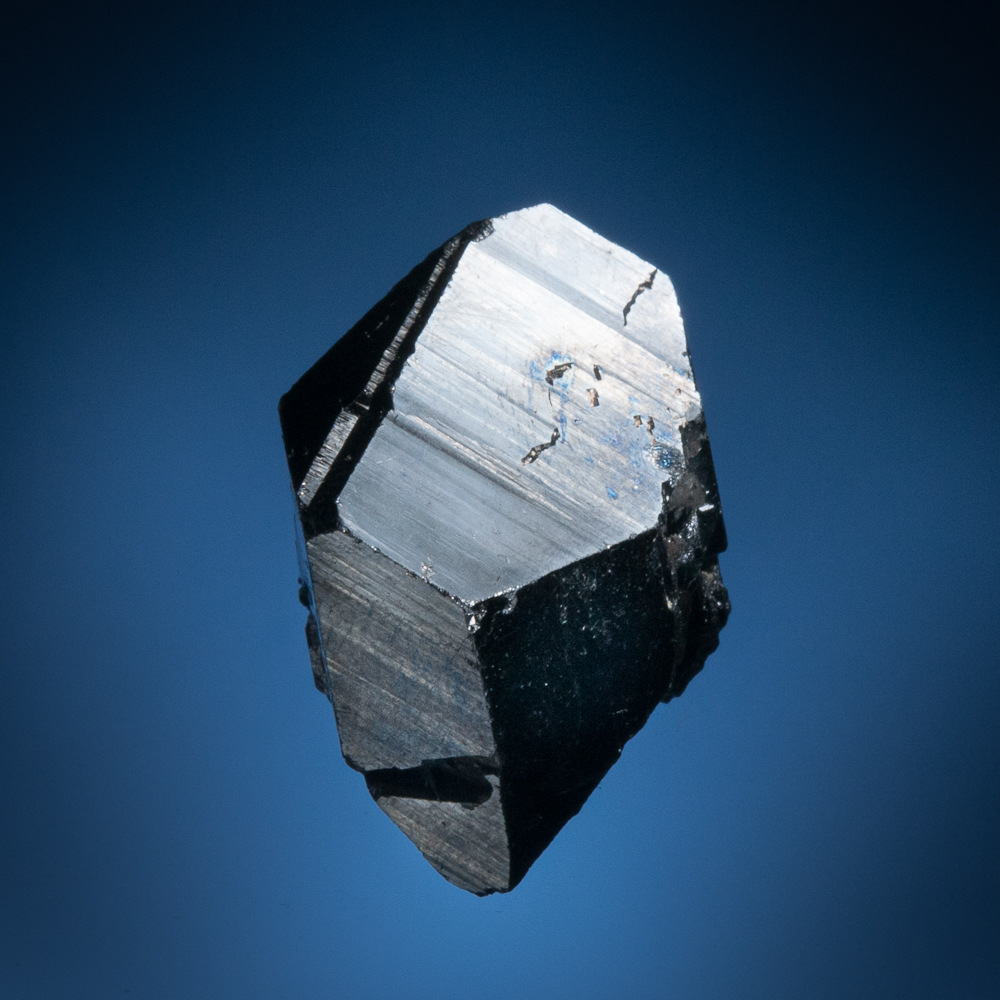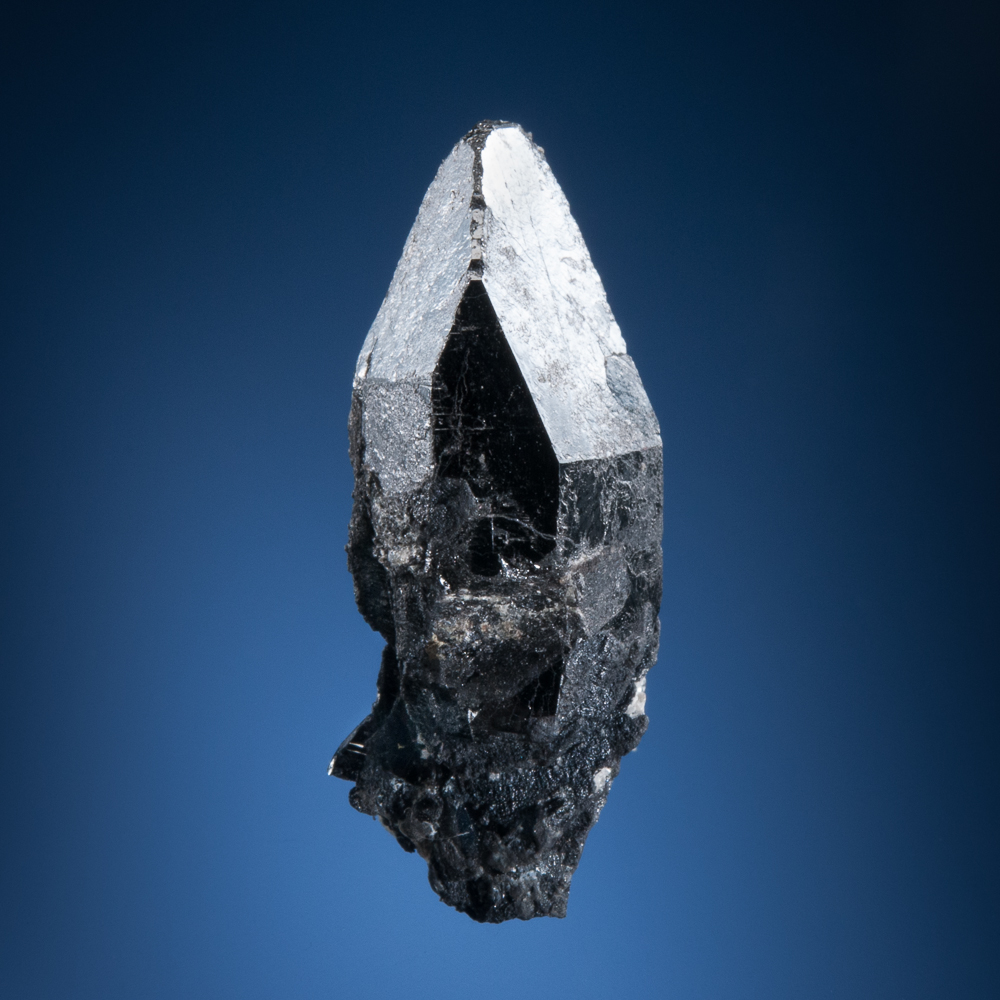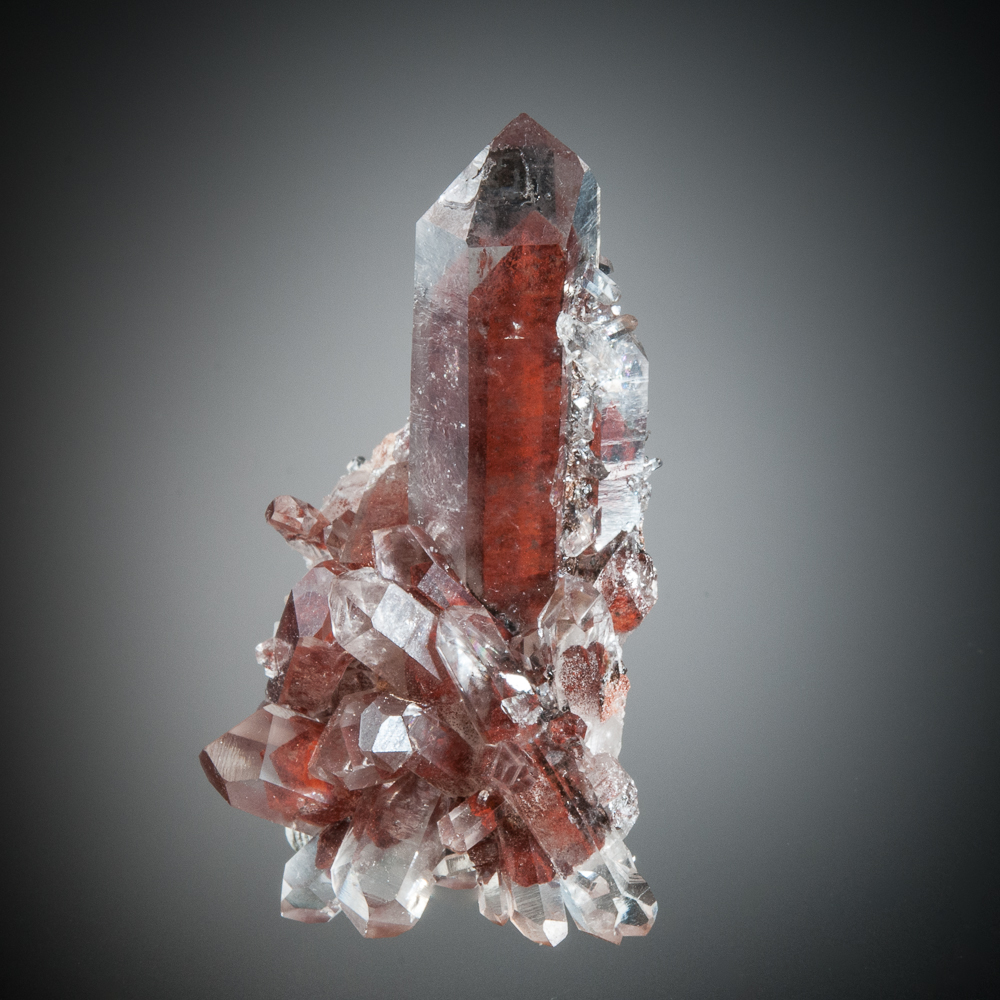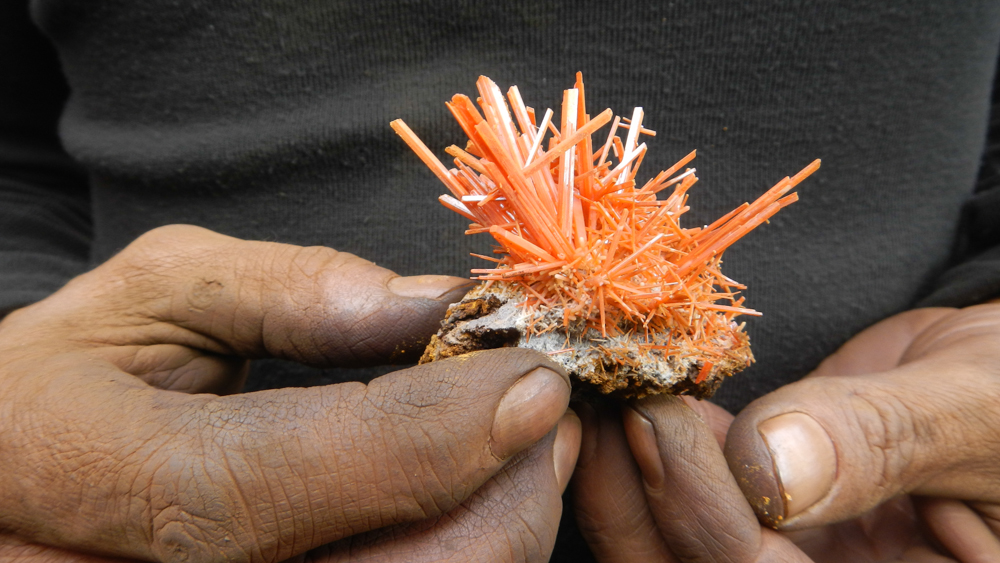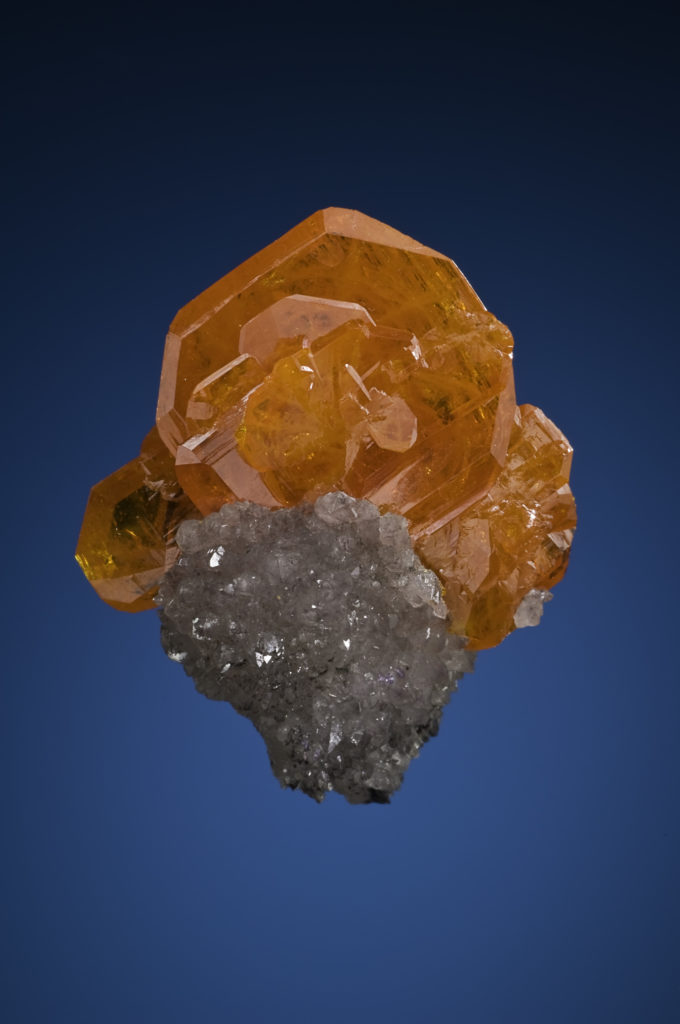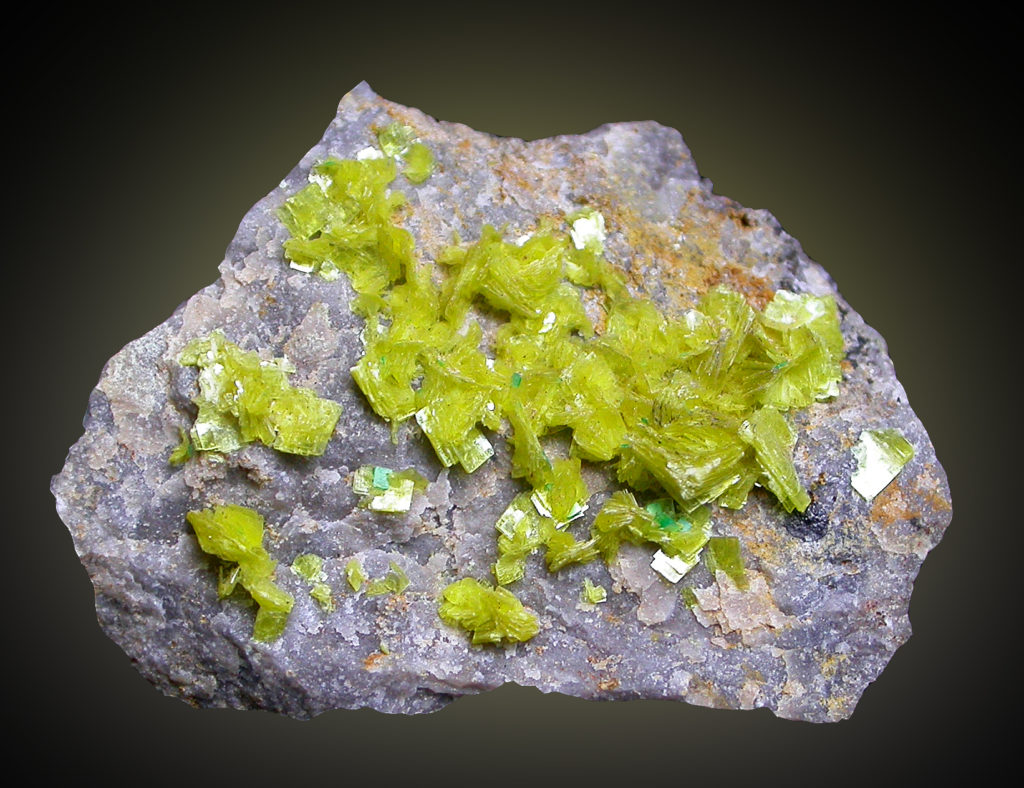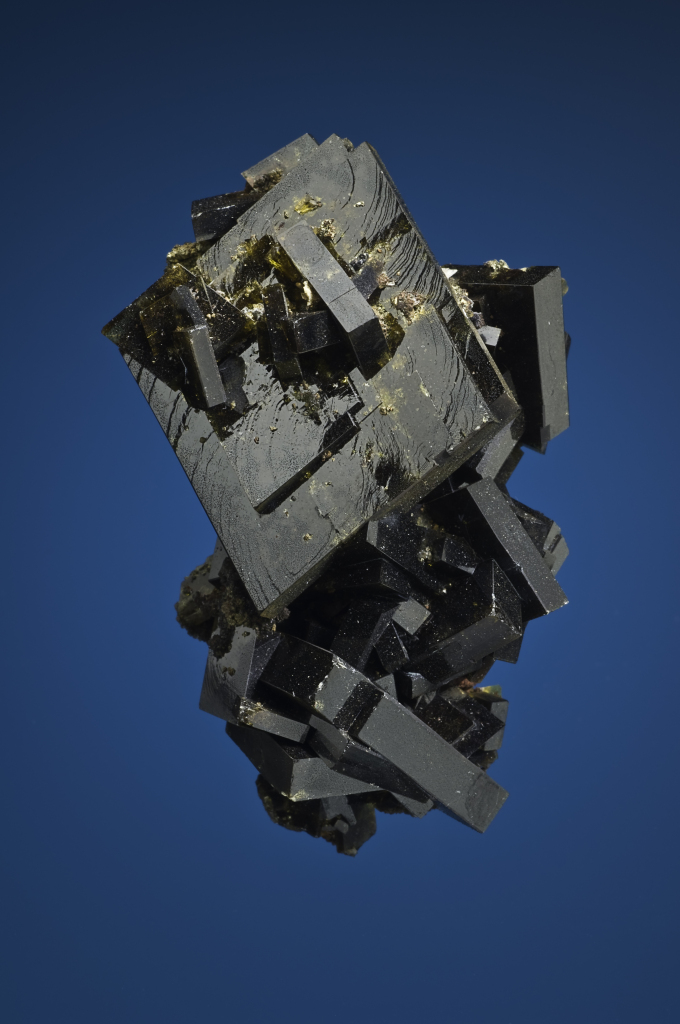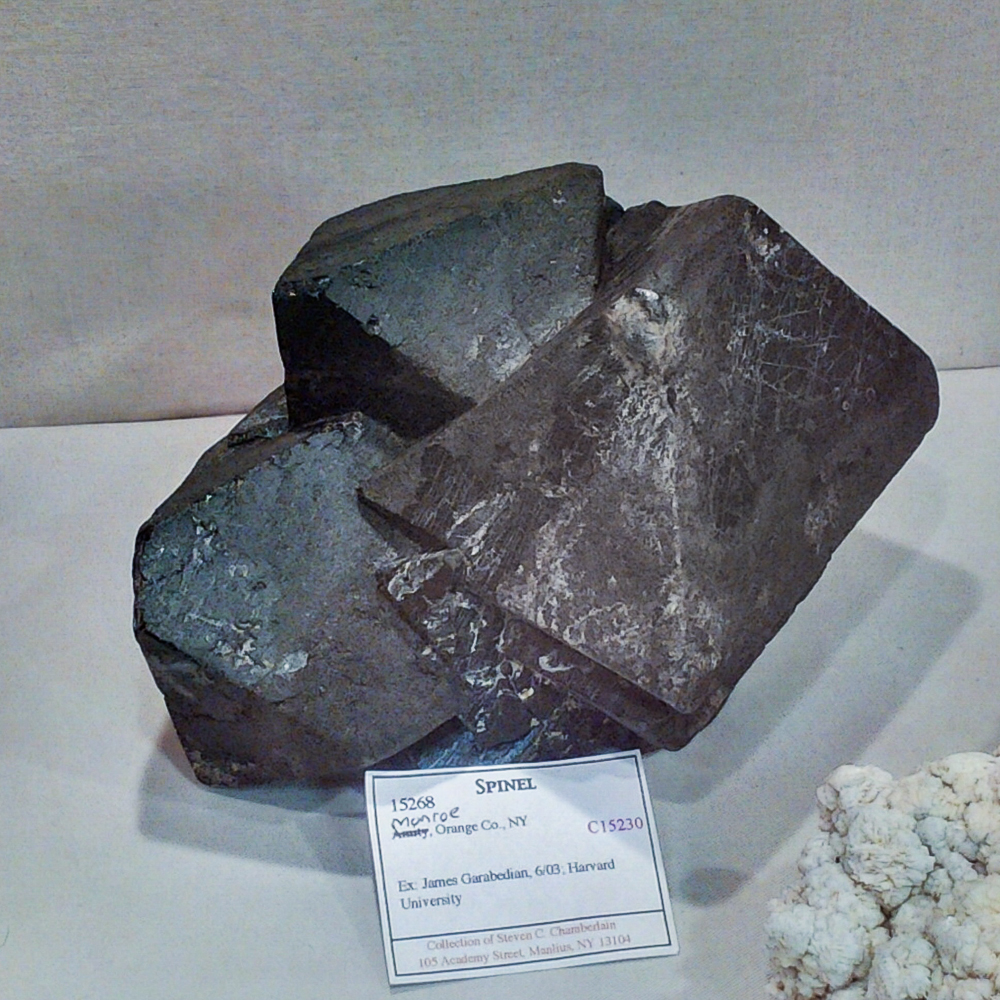Categories
Archives
I’m publishing this one a bit later than I expected this year, but I hope you will enjoy the content all the same. And for those of you who are in hot summer places, perhaps harking back to northern spring will feel refreshing…
Each year, I personally love the arrival of the Rochester Mineralogical Symposium for two reasons.
First, it’s my favourite annual event in Mineral World. And second, the RMS always marks the arrival of spring out here in the Bancroft woods, with nicer temperatures and the occasional chance to drive with the windows down again.
So, in this photo taken the day before the Symposium, I’ll leave it to you as to whether Emery’s happy expression was about hanging out the window and soaking up the early spring sunshine or the arrival of RMS 2017…
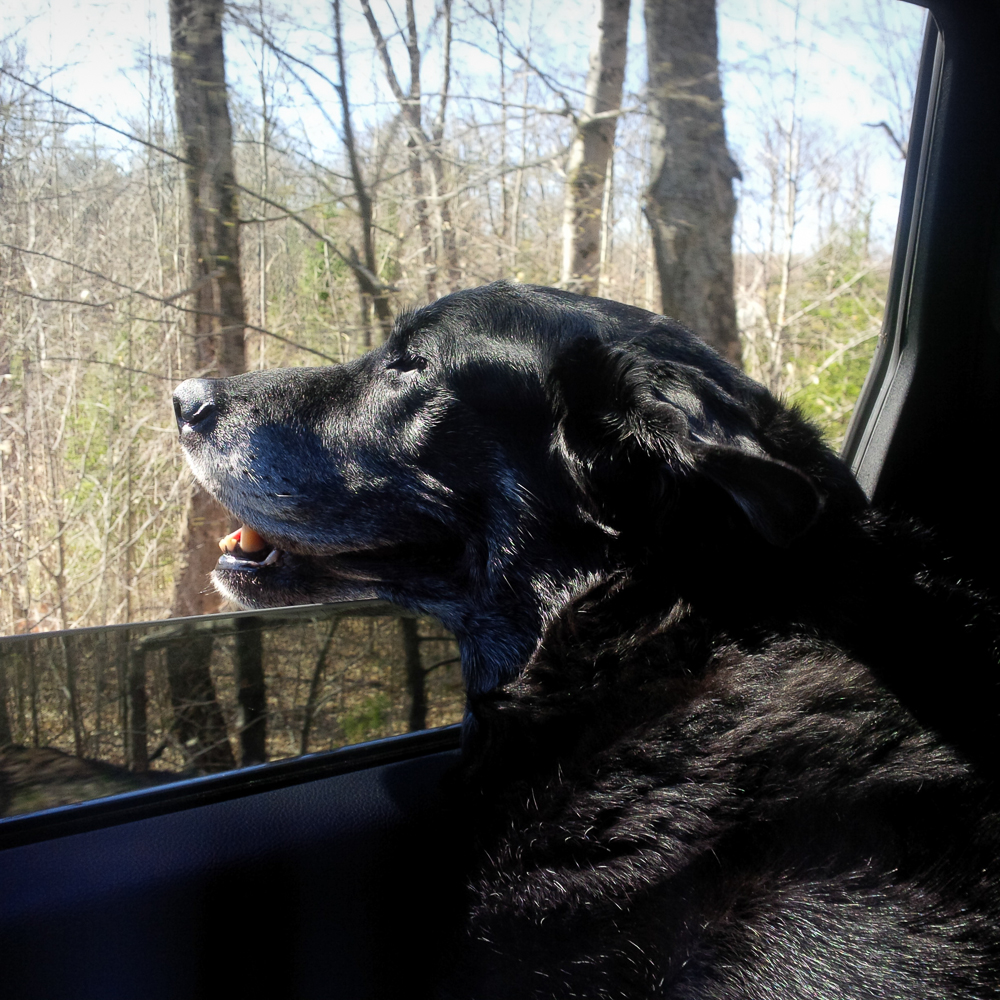
…but my own happiness that day was about both!
If you’ve attended the RMS, you’ll know why it’s special. The Rochester Symposium is a unique event. It brings together professionals and amateurs, and a complete range of subjects in specimen mineralogy. It is collegial and friendly, meant for collectors and those who love to learn about minerals. The RMS prominently features What’s New in Minerals each year. It is also a mineral show with excellent dealers set up and open when the talks are not on. And the RMS is a true mineral community with great cameraderie – it’s a time for hanging out and having a good time with mineral friends, new and old. It’s possible a drink or two is shared among us, and a few mineral songs are always sung.
If you haven’t yet come, I hope you’ll join us next year. Rochester is meant for you as much as anyone! You can reserve the dates right now: April 19-22, 2018.
2017 RMS Presentations
Opening – Bill Pinch
We began the 2017 (44th) RMS acknowledging the passing of our friend Bill Pinch, the great mineral collector who began the Symposium 44 years ago. As this had happened only three weeks before the Symposium, this was a hard period for Bill’s family and friends.
At RMS 2017, the Program Notes began with an In Memoriam, written by Chairman Steve Chamberlain – I have reproduced it in full, below. Bill’s website hosts both a great In Memoriam by Mark Feinglos (which he wrote for The Mineralogical Record) and some other great links – I include the link below, under Links and References.
Steve also announced that RMS 2018 will be dedicated to Bill’s memory and, in celebrating him, we will have a Bill Pinch theme. In addition to a presentation about Bill himself, there will be talks on the subjects he loved most during his collecting career, including Tsumeb, rare minerals, and collecting fine minerals.
Bill was a good friend and a kind mentor to me. What we enjoyed most – as I’m sure was true with so many of his mineral friends – was losing all sense of time together talking about minerals. And so that’s what we all did at RMS 2017 – we enjoyed each other’s company and immersed ourselves in minerals.
The King of Tides: Nova Scotia’s Bay of Fundy
I gave the first talk of the 44th Rochester Symposium, about the minerals of the Bay of Fundy. For those of you who know my website, you will have seen the articles I have posted on the blog (Collecting the Bay of Fundy, and Collecting on the Islands). Although the RMS presentation was about the minerals from the classic Bay of Fundy localities discussed in the blog posts, I had a different goal in putting it together. My goal was to share not only the story and scenery, but specifically some of the top specimens, to show how great they can be. Those specimens reside primarily in a few Canadian collections, and so there was a collaborative effort to track them down and photograph them. This talk was only possible with the involvement of several people, so the presentation slides have four additional authors – Terry Collett, Ronnie Van Dommelen, Michael Bainbridge and David Joyce. Together, our efforts resulted in a well-received talk and many photographs of specimens that, until now, have not been well-known beyond our local circles. Some stunning pieces have been found on the Bay of Fundy.
Chabazite, Wasson’s Bluff, Cumberland Co., Nova Scotia – 7 cm
Terry Collett collection, Ronnie van Dommelen photo.
Chabazite on Heulandite, Wasson’s Bluff, Cumberland Co., Nova Scotia – 14 cm
Ronnie Van Dommelen collection and photo.
Chabazite, contact twin, Wasson’s Bluff, Cumberland Co., Nova Scotia – 1.2 cm crystal
(Penetration twins are common at Wasson’s Bluff, but contact twins are not.)
David Joyce collection and photo.
Copper, Cape D’Or, Cumberland Co., Nova Scotia – 15 cm
Largest spinel-law-twinned crystal 5 cm
Robert Beckett collection, Michael Bainbridge photo.

Copper, Cape D’Or, Cumberland Co., Nova Scotia – crystal 15.7 cm
Rod and Helen Tyson collection, Michael Bainbridge photo.
Thomsonite, Cape D’Or, Cumberland Co., Nova Scotia – 10.5 cm
Originally in the Doug Wilson collection, now George Thompson collection,
Michael Bainbridge photo.
Natrolite, Diamond Island, Five Islands, Cumberland Co., Nova Scotia – 18 cm
Ronnie Van Dommelen collection, Michael Bainbridge photo.
Stilbite, Five Islands, Cumberland Co., Nova Scotia – 5.7 cm
Rod and Helen Tyson collection, Michael Bainbridge photo.
Michael Bainbridge is taking superb photos for collectors and publications these days – a link to his website is below, under Links and References.
Overview of Silicate Structures
At the last minute, Dr. Frank Hawthorne was unable to attend and present at the RMS. Thanks to an above-and-beyond effort by Dr. Robert Lauf, this talk was in fact still presented at the RMS – Bob was up into the wee hours of the night working with the original slides to that he could then give both this talk and his own talk on Friday morning.
Bob gave a tough subject and it was a great morning for learning. After a late night of fun with friends, it’s not easy to greet the next morning in a dark presentation room hearing the opening statement “silicates are a complex business…”
However, this talk gave context and focus for what is in fact an important issue in mineral work.
Silicate structures have been generally understood since the 1930s, when William Bragg developed the silicate groups that are still in use today. Those groups are defined on the basis of the nature of the structural organization within the minerals. Silicates are all defined by having a silicon-oxygen tetrahedron- SiO4 – at the heart of their structure, and the key differentiating factor among silicates derives from the way in which each such Si04 tetrahedron is linked to others. This linkage is determined by the way in which the SiO4 tetrahedron shares the other elements within the mineral. This can result in chains, rings and other arrangements, and as a result, the silicates are grouped on this basis – inosilicates, cyclosilicates, orthosilicates, tetrasilicates.
Silicate structures are vitally important, and this talk highlighted why. When we are conducting analyses to identify and define minerals, we can know certain things from chemical analysis, but ultimately we may need to combine chemical and structural analysis to arrive at a proper definition and identification. In fact, structural analysis can be determinative. For example, the mineral wiluite is identified conclusively by understanding the structure – the structure will reveal which site in the mineral’s composition is occupied by boron, and that is determinative in the correct identification.
The silicates require much more structural work. Although definitive work has been completed with other mineral groups, the same cannot be said for the silicates – it is an overwhelmingly large subject, with lots yet to be done.
Orthosilicates
Fresh off giving the first talk, Bob Lauf was up at the podium to give the talk he had planned to give – an overview of the orthosilicate minerals. The orthosilicates include many awesome minerals, such as the titanite group, the zircon group, the garnet group, the humite group, vesuvianite and topaz, and this talk included many photos.
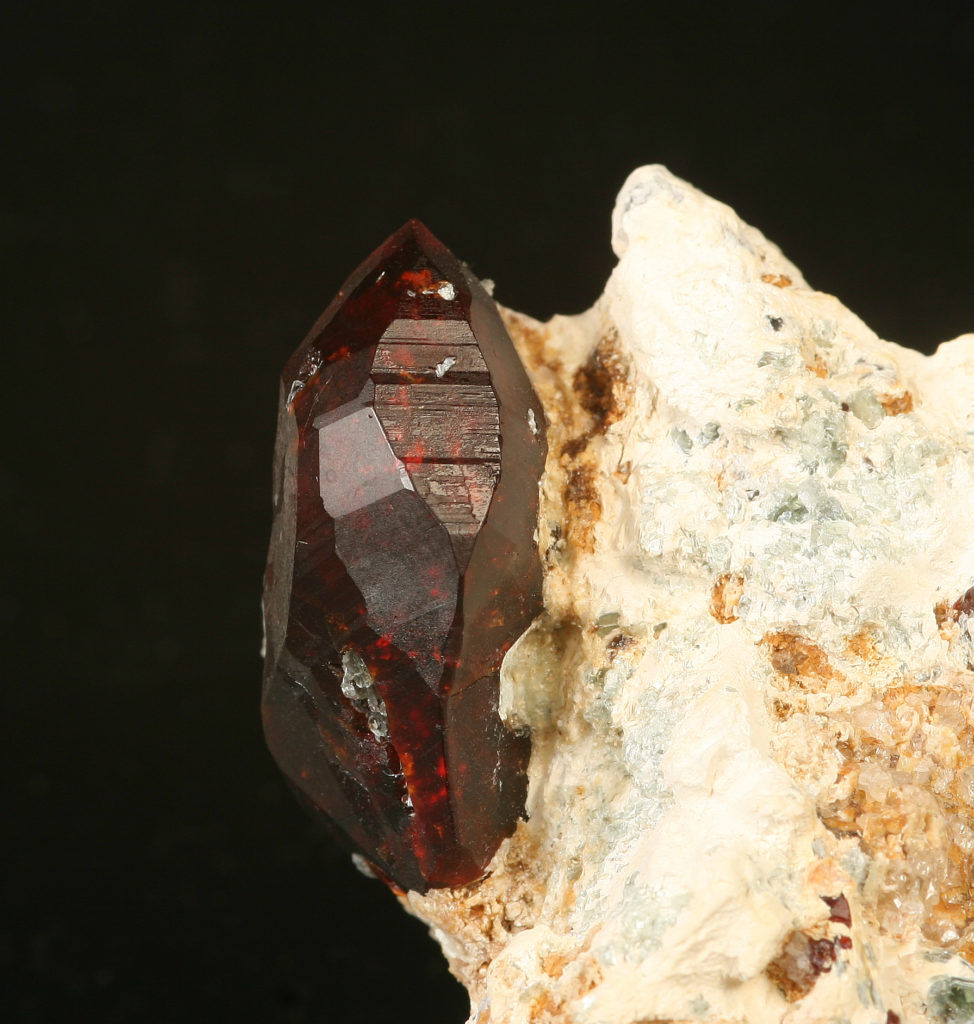
Clinohumite, Jikhan, Koksha Valley, Badakhshan, Afghanistan 2.5 cm crystal
R. Lauf specimen and photo.
The orthosilicates are defined not by chains or rings, but by isolated groups of SiO4 tetrahedra. Bob likened the results of packing these SiO4 groups, together with the metals, to packing groups of organized ball bearings, with configurations that vary mineral to mineral. In general, the orthosilicates have dense, tightly-packed structures, and this can often mean a high surface hardness and toughness – many of these minerals survive weathering exceptionally well. Meanwhile, properties like cleavage, striations and crystal forms are determined by the metals within the structure, not the SiO4 tetrahedra.
Bob has a new book out, Collectors’ Guide to Orthosilicates. A link is below under Links and References.
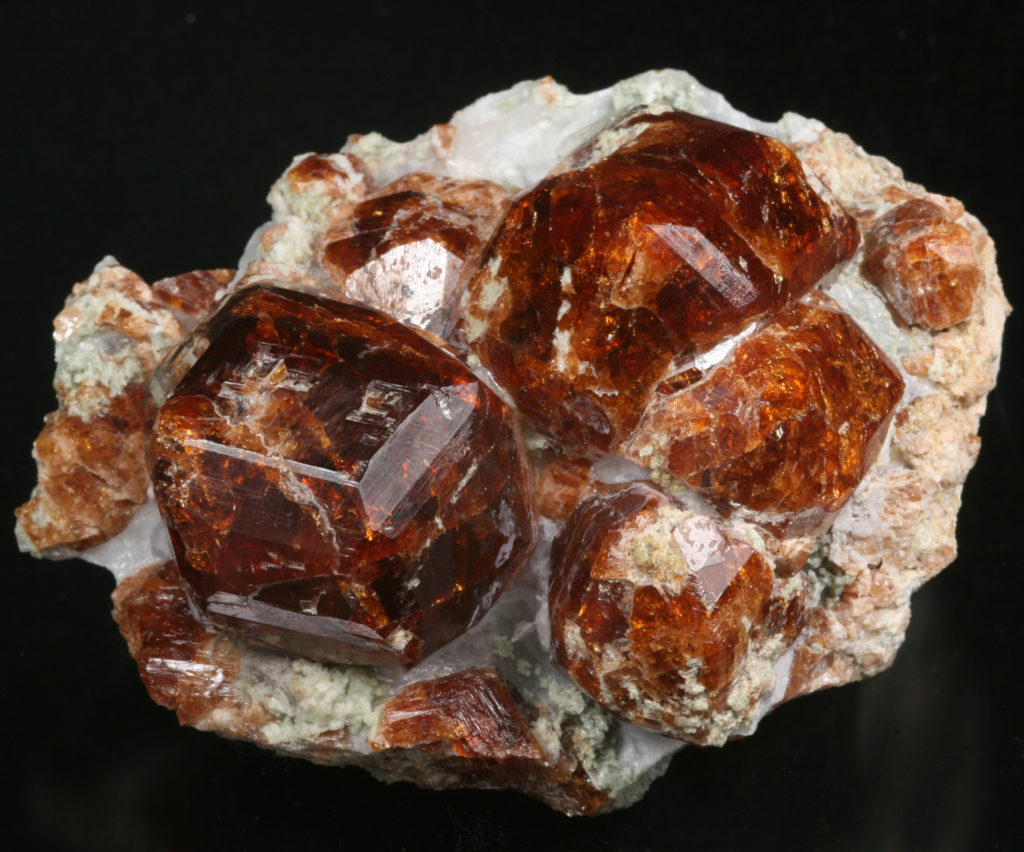 Grossular, Calixico, California – 8 cm
Grossular, Calixico, California – 8 cm
R. Lauf specimen and photo.
Technical Session
Every Friday afternoon at the RMS, we have what we colloquially call the “Technical Session”, Contributed Papers in Specimen Mineralogy, moderated by Dr. Carl A. Francis. This session is packed with great 15-minute talks on a range of topics, some completely specimen-oriented, some more mineralogical. I don’t write at length in these blog posts about the Technical Session talks, because the abstracts from these talks are published during the year in Rocks and Minerals magazine (don’t forget to watch for them!) and they are published in the RMS Program Notes.
However I really want to highlight the Technical Session for a moment this year. One reason is because the Technical Session is one of the features that makes Rochester unique, with professionals and amateurs all contributing. For collectors, there is a lot of interest in these talks – sometimes about rare or new minerals or finds, sometimes about localities, sometimes about scientific work done to establish fakes in Mineral World. And perhaps even more this year than in recent memory, we had a high percentage of truly excellent talks given by students. The group from the Department of Geology and Environmental Earth Science, Miami University, Oxford, Ohio did a particularly outstanding job. Too often, we look around Mineral World and see fewer young people than we’d all like – these students represent a bright future for mineralogy and the science that underpins everything we enjoy in Mineral World.
Friday Night
The Monteponi Mine, Sardinia, Italy
Our Friday night presentation was The Monteponi Mine, Sardinia, Italy, given by Dr. Renato Pagano, one of the world’s pre-eminent mineral collectors. The Renato and Adriana Pagano Collection includes 13,500 specimens, and 4,300 species, making it one of the most remarkable collections ever assembled.
Renato gave a great talk on this classic locality, with great photos. One of my favourite facts from the talk was the origin of the name Monteponi (since we’ve all seen it on musuem labels and in the literature for decades…). The name has evolved from its original name, Monte Paone. Paone was an old Italian word meaning peacock, so it is Mount Peacock. Monteponi is a slightly (!) older locality than our New World ones – the Carthaginians mined silver-bearing galena there from the 6th century BC, and Monteponi later provided silver and lead to the Roman Empire, particularly for coinage and pipes, respectively. Renato took us through the history and stories from the past, including the tragic incident in which one of the great phosgenites was presented as a gift to a clumsy Swedish ambassador who dropped and destroyed it.
Among collectors, Monteponi is most famous for having produced the world’s finest phosgenite crystals.
I had to include this one in this post – I have loved this crystal for about 40 years, as its photograph was featured in one of the first mineral books I ever owned, as a child (Encyclopedia of Minerals and Gemstones).
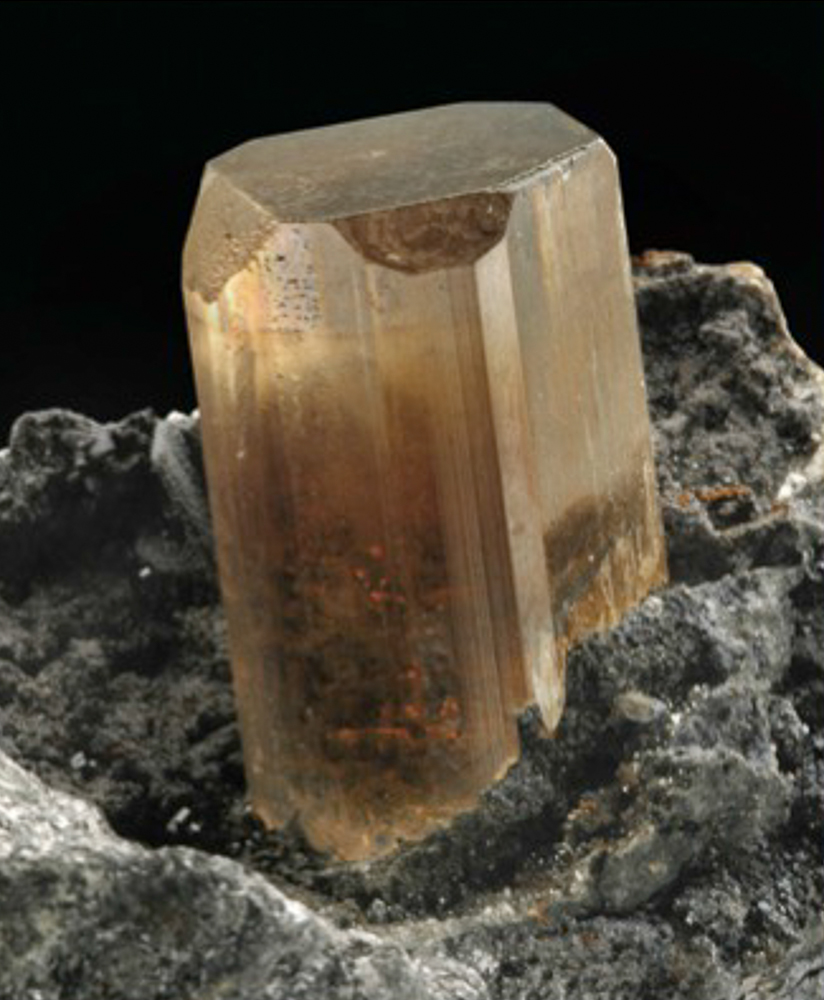 Phosgenite, Monteponi, Sardinia, Italy – 2.5 cm crystal
Phosgenite, Monteponi, Sardinia, Italy – 2.5 cm crystal
Milan Natural History Museum specimen, Roberto Appiani photo.
And here are two great phosgenite specimens from the Pagano collection:
Phosgenite in a vug in galena, Monteponi, Sardinia, Italy – 6 cm
Renato and Adriana Pagano collection, Roberto Appiani photo.
Phosgenite crystals, Monteponi, Sardinia, Italy – 2 cm
Renato and Adriana Pagano collection, Roberto Appiani photo.
Monteponi is also known as a locality for exceptionally fine anglesite crystals.
Anglesite, Monteponi, Sardinia, Italy – 8 cm
Renato and Adriana Pagano collection, Roberto Appiani photo.
A comprehensive article on Monteponi by Renato, together with Wendell Wilson, is included in The Mineralogical Record, November-December 2014, Vol. 45, No. 6 . If you haven’t yet read it, it’s superb, and if you read it when it came out, maybe time for another read…
Saturday – Annual What’s New
At the heart of the Rochester Symposium for decades, the annual Saturday morning presentations have captured highlights of what has been new in Mineral World over the prior year or so, focusing on fine mineral specimens for collectors.
What’s New in Minerals and Localities – Part I – Jeff Scovil
Jeff Scovil leads our worldwide survey of exceptional new mineral specimens, with an hour of stunning photos. It doesn’t matter who was up for how long having fun the night before, the room is always packed. Jeff’s presentation is always a Symposium highlight!
So here are a few photos to give you a sense – imagine an hour of this… It’s Mineral Heaven!
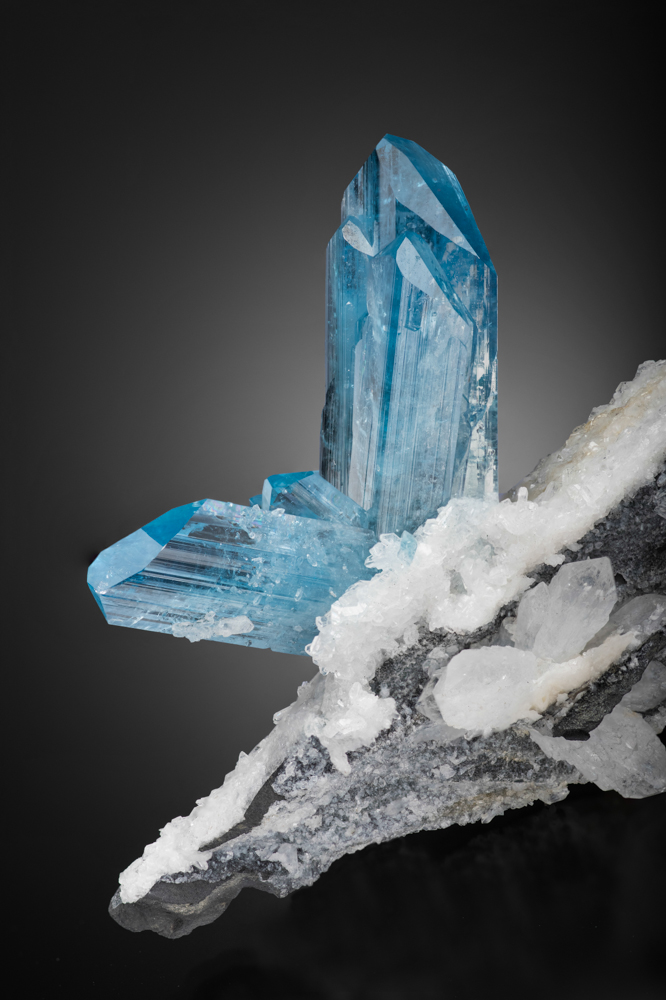
Euclase, La Marina Mine, Muzo District, Boyaca, Colombia
Crystals to 5 cm
Irv Brown collection, J. Scovil photo.
Djurleite, Aït Ahmane MineBou Azzer, Ouarzazate, Morocco – 4 cm
Steve Smale collection, J. Scovil photo
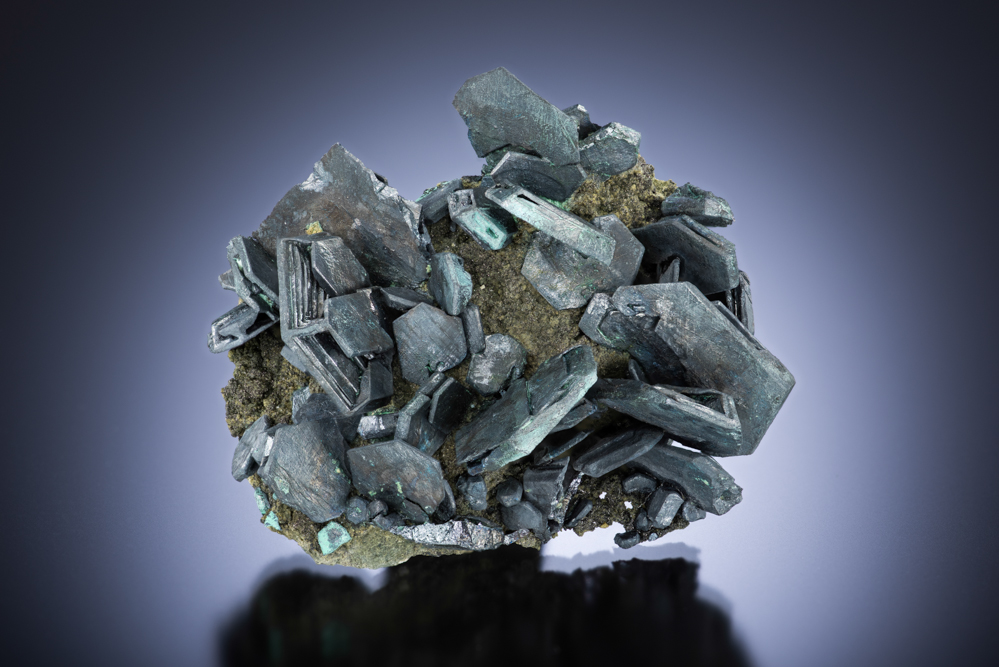
Djurleite, Aït Ahmane Mine, Bou Azzer, Ouarzazate, Morocco – 6 cm
Fine Gems and Minerals specimen, J. Scovil photo
Wulfenite, Jianshan Mine, Xinjiang, China – 4.3 cm
Sam Yung specimen, J. Scovil photo.
Fluorapophyllite, Aurangabad, Maharastra, India – 3.2 cm
Spirifer specimen, J. Scovil photo.
Elbaite tourmaline with albite, Ouarzazate, Morocco – 3.3 cm
Spirifer specimen, J. Scovil photo.
Fluorite, Huanggang Mines, Inner Mongolia, China – 8.9 cm
Steve Smale collection, J. Scovil photo.
And this last one may not be quite as recent, but the photo is, and the lighting on these crystals is simply as good as mineral photography can get…
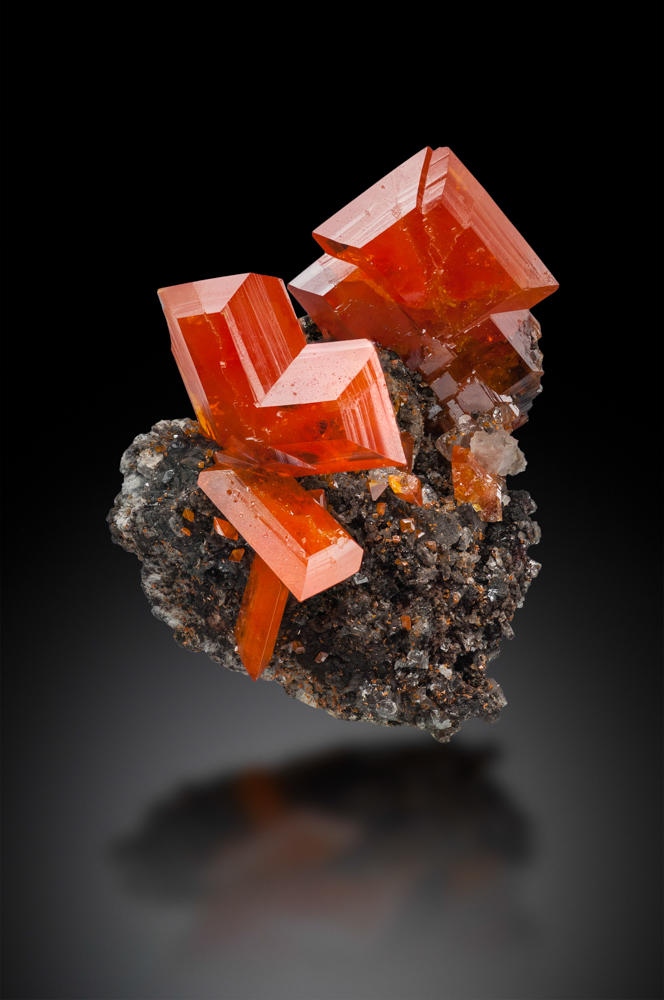
Wulfenite, Red Cloud Mine, Trigo Mountains, La Paz Co., Arizona – 3.9 cm
Unique Minerals specimen, J. Scovil photo.
Jeff is the Yoda of mineral photography. If you would like him to photograph your minerals, or you are looking for mineral photos for a publication, his website is under Links and References.
What’s New in Minerals and Localities – Part II
Part II of What’s New in Minerals is open to contributions from attendees. We had a couple of presentations about new books, including one mineral book, an upcoming book by Van King on Franklin, New Jersey, so we’ll keep our eyes open for that.
I then presented a few more examples of what has been new in Mineral World over the last year or so. If you’ve been following this website over the past year, you’ll be familiar with most of these.
Just a note of explanation about photographs here. Below each photo, I am including a link to the applicable blog post on the website where you can see more photos and specimens than are here. (Every new mineral update on this website is represented by a blog post, so even if you didn’t see a specimen before it sold and was removed, there is a nice record of my favourite photos from each update preserved in the blog.)
I’ll begin with the “Synchysite Mystery”… this goes back to a find from 2015, but the analytical work was completed in 2016…
In late 2015, I had posted on the website a small number of “synchysite” crystals from Novo Horizonte, Bahia Brazil. Although they had been sold to me as synchysite, some question arose as to confirmatory identification of these, in part thanks to some work that was ongoing to describe the new mineral parisite-(La) (described in my Tucson 2017 blog post). Analysis by Don Doell, first at the lab at University of Arizona, began to confirm more about their identity. Don then conducted semi-quantitative EDS at SGS Labs and narrowed things down. These are in fact phosphate mineralization: they are likely a combination of rhabdophane-(La), rhabdophane-(Ce) and possibly including monazite-(Ce). They appear to be pseudomorphs after a REE carbonate, probably in the parisite group, given that parisite-(La) has been found at Novo Horizonte in crystals with a similar aspect and appearance, at a similar time (therefore possibly similar part of the deposit). They could also be after bastnasite-(La), which has been described from the locality, although these are most similar in aspect to the parisite-(La) crystals. For now, I’m labelling them rhabdophane, pseudomorph after parisite, with the proviso that the above is the technically closest identification information to date. Thanks very much to Don for this analysis!
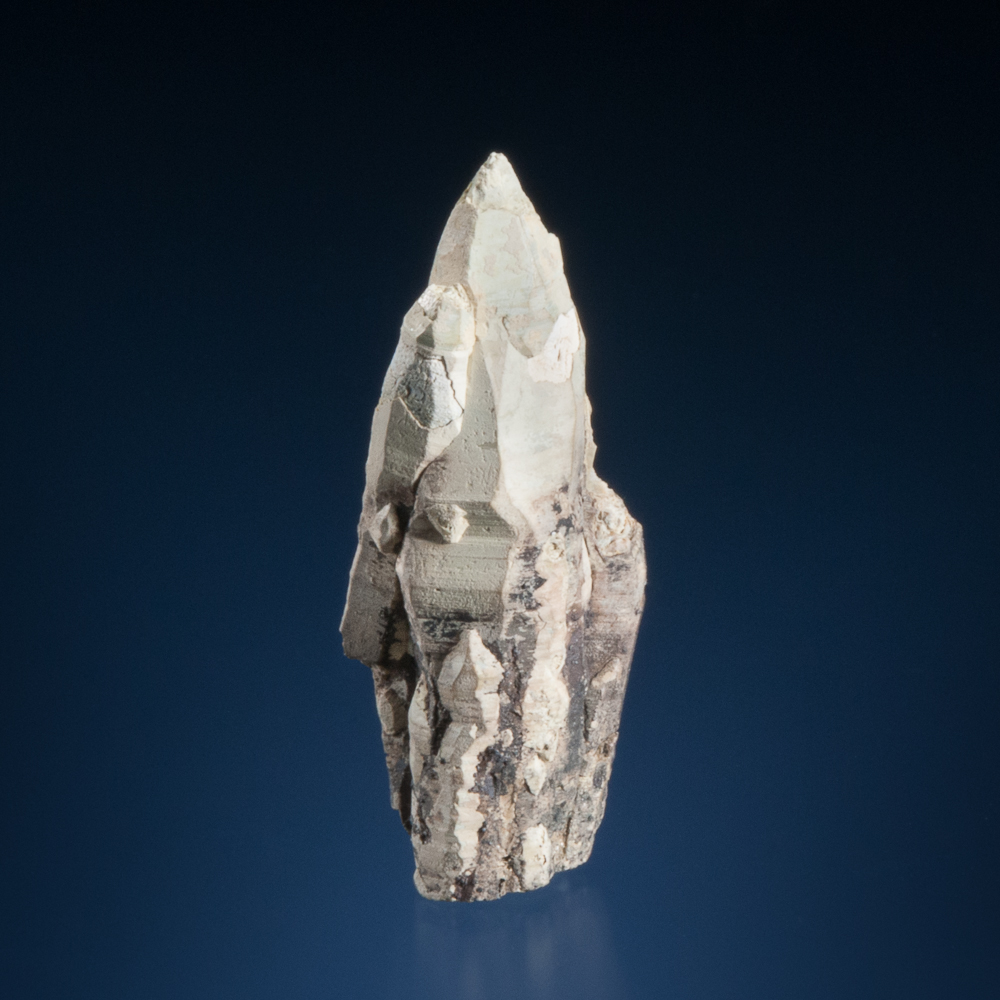 Rhabdophane, ps Parisite, Novo Horizonte, Bahia, Brazil – 4.3 cm
Rhabdophane, ps Parisite, Novo Horizonte, Bahia, Brazil – 4.3 cm
(More photos/specimens)
A few other “What’s New” entries:
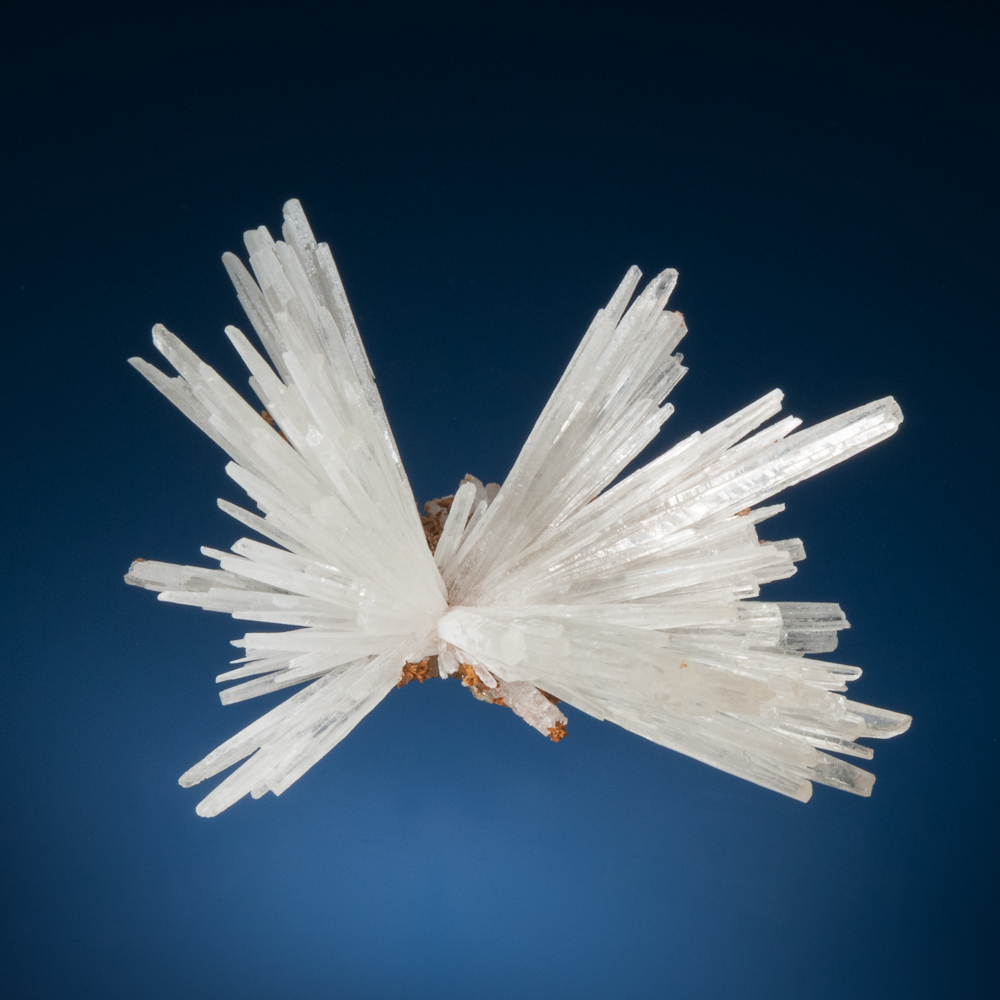
Aragonite, Mamsa, nr. Sidi Ayed, Boulemane Province, Fes-Meknes Region, Morocco – 6.9 cm
W.W. Pinch collection.
(More photos/specimens)
Rutile, var. Struverite-Ilmenorutile, Santa Rosa Mine, Itambacuri, Doce Valley, Minas Gerais, Brazil – 3.1 cm
(More photos/specimens)
Wodginite, Linopolis District, Divino das Laranjeiras, Minas Gerais, Brazil – 3.2 cm
Jack Smith collection.
(NB: If you are interested in these, I was able to acquire five more in Ste. Marie and they will be on the website soon)
(More photos/specimens)
Quartz with Red Phantoms, Orange River, Northern Cape Province, South Africa – 5.2 cm
(More photos/specimens)
More Saturday Presentations
mindat.org – Sixteen Years On: How mindat is Driving New Scientific Discoveries
Jolyon Ralph followed with a talk about mindat as it is today, status, and uses. (Jolyon has presented to the RMS on mindat before, so this was an update). As perhaps all of you know, mindat.org is a “Wikipedia”-like site for mineral information, contributed by users and monitored by administrators. What fewer of you may know (along with me, I didn’t!) is that mindat now hosts over 5 million pages, including 800,000 photographs and profile information for 280,000 localities. (!) (As an aside, Jolyon calculated that the information on mindat would now print a stack of paper 5 km tall.)
Jolyon explained how mindat is now being used for scientific studies and more analytical use. He highlighted that mindat is now being used to draw links between localities, particularly with a view to predictive occurrence among similar types of deposits and occurrences. He also explained that an important consideration when using mindat relates to the biases of users and contributors. For example, there is far more collector interest in crystals of wulfenite than there is in crystals of nepheline, so the amount and quality of information on mindat for wulfenite is different than it is for nepheline.
Mindat is an incredible resource and it was interesting to hear the new ways in which it is being used.
Upside Down and In the Future – Mining Tasmania’s Adelaide Mine
Saturday afternoon was amazing. John Cornish led off with his great talk about the Adelaide Mine in Tasmania, the world’s preeminent crocoite locality. John is involved with the Adelaide Mine project and shared his experience with enthusiasm! He took us on a tour of the mine region, with great information on local flora, fauna and history. And then he took us underground, to see pockets of crocoite up to 7×4 metres. (!) Just amazing…
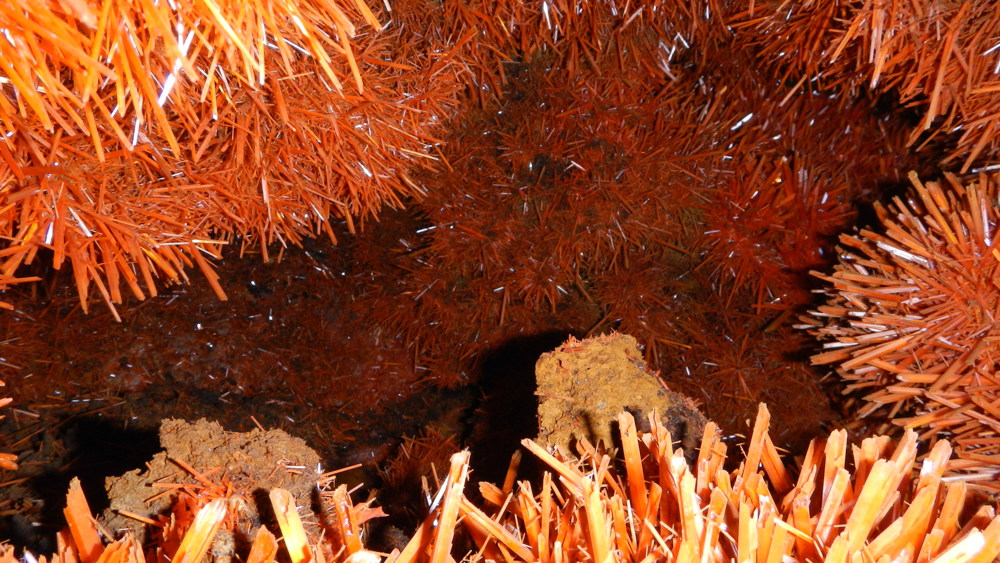 Crocoite Pocket at the Adelaide Mine, Tasmania
Crocoite Pocket at the Adelaide Mine, Tasmania
John Cornish photo.
There was one particular story I had not heard and really enjoyed…
All field collectors must adapt to the conditions and nature of the occurrence they are working. What that means in practice is that often the tools that will be of most help will vary wildly from one mineral locality to the next. And I think it’s safe to say that all of us who have done field work for a long time have found resourceful ways of addressing issues, and collecting more efficiently. Often, the need for resourcefulness is driven by our desire to minimize the risk to specimens in the extracting process. Clearly, care is required when collecting crocoite! And in his focus on minimizing damage, John had a resourceful way of minimizing percussion and therefore lowering the risk of popping crocoite crystals off…
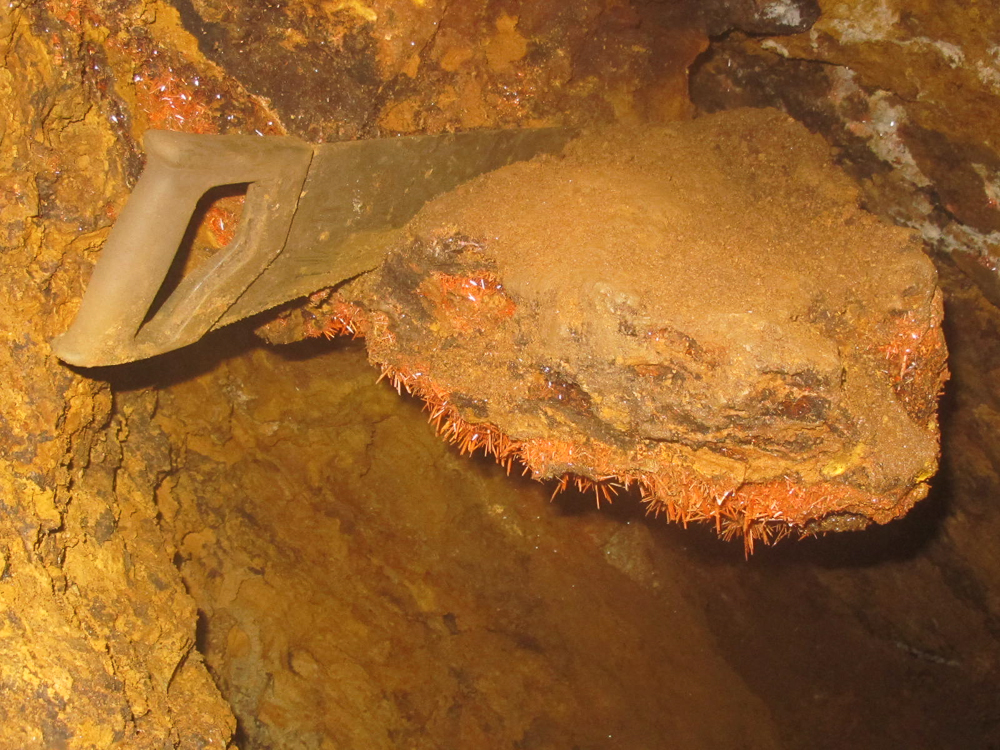 Trimming crocoite matrix with a hand saw, underground at the Adelaide Mine, Tasmania
Trimming crocoite matrix with a hand saw, underground at the Adelaide Mine, Tasmania
Brilliant!
John Cornish photo.
Some of the specimens recovered from the Adelaide Mine have been huge. Sometimes with large specimens in the field, we might include a prospector’s pick for scale. But in this case, John simply had himself included for scale.
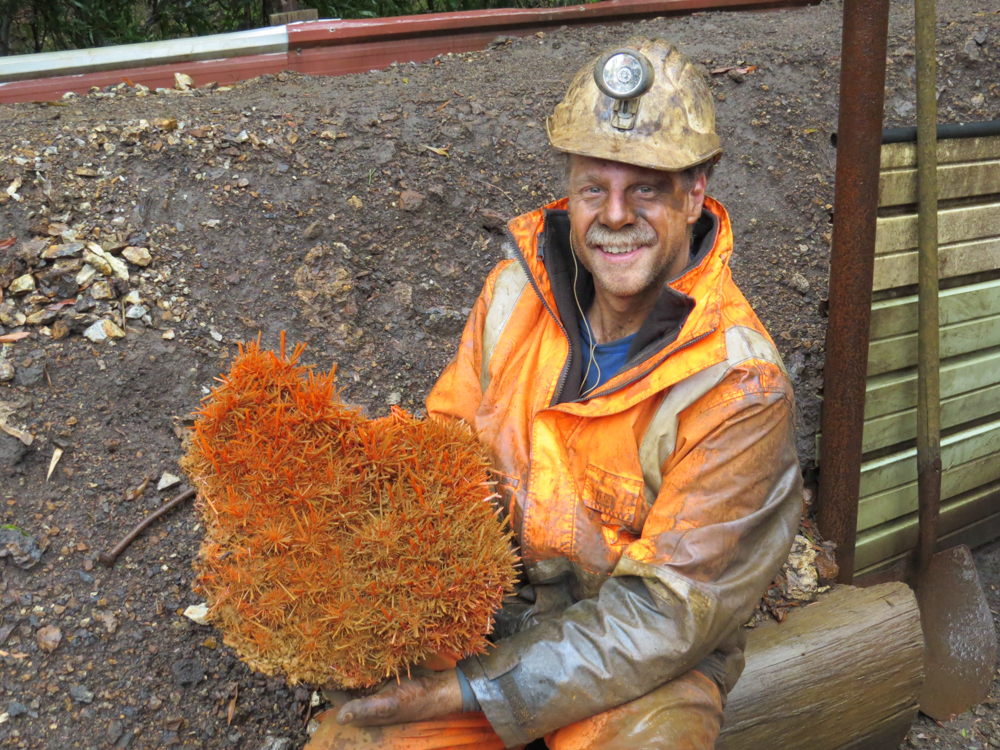 Crocoite from the Adelaide Mine, Tasmania
Crocoite from the Adelaide Mine, Tasmania
A very happy, if dirty, John Cornish for scale.
Crocoite from the Adelaide Mine, Tasmania
John Cornish photo.
John’s enthusiastic account was a highlight of RMS 2017.
If you are interested in seeing a bit more online about the Adelaide Mine, and more crocoite specimens, I am including a link to the Adelaide Mining Company’s website below, under Links and References.
Red Cloud Mine – The World’s Greatest Wulfenite Locality
John’s talk was a hard act to follow, but was Les Presmyk ever up to the task…
Les presented on the Red Cloud Mine, a locality that has inspired many of us as collectors since we began collecting minerals. Who doesn’t dream at night of perfect, glassy, sharp, lustrous. red-orange bevelled-square wulfenite crystals from this legendary mine? (Be honest.)
The Red Cloud is located in the Trigo Mountains, near the western border of southern Arizona. It was named after the prehistoric Red Cloud Trail, which leads to the west, on the California side of the Colorado River nearby.
Les took us through the early history of the mine, with some fascinating insights. One I liked was the explanation that because it is so relatively barren with no trees, lumber had to be brought in for quite a distance and was therefore expensive. Of course they did this to timber the mine tunnels, but it was too expensive for miners’ homes. So, the miners made their homes by digging tunnels into the side of the hill, to protect themselves and their belongings from the elements.
This presentation focused on significant mineral collecting at the Red Cloud over the years, beginning with Ed Over’s famous finds in the 1930s, and detailing the 1990s project by Wayne Thompson, James Horner and Les. During this time, the Red Cloud Mine was developed as an open pit operation, specifically for wulfenite specimens.
The most striking fact for me about this project was that from 1995 through 1999, only one significant pocket was found during the entire project – the 1997 pocket, that measured approximately 6 ft x 4 ft. That was it. For all the money spent on each year’s mining, very little was found. After major overburden removal beginning in 1995, and mining for months in advance of the Tucson show in early 1997, the team had assembled one flat of “decent” specimens from vugs and small pockets (under 10cm). Later in 1997 they hit the significant pocket, and from then until they stopped, very little was found – scare pockets and a few good specimens. Suffice it to say, for the period following the 1997 pocket, the expenses far exceeded the value of specimens recovered. This puts into real perspective just how remarkable it is to have excellent Red Cloud wulfenite specimens from any era – they are rare and have come out of the ground at major cost.
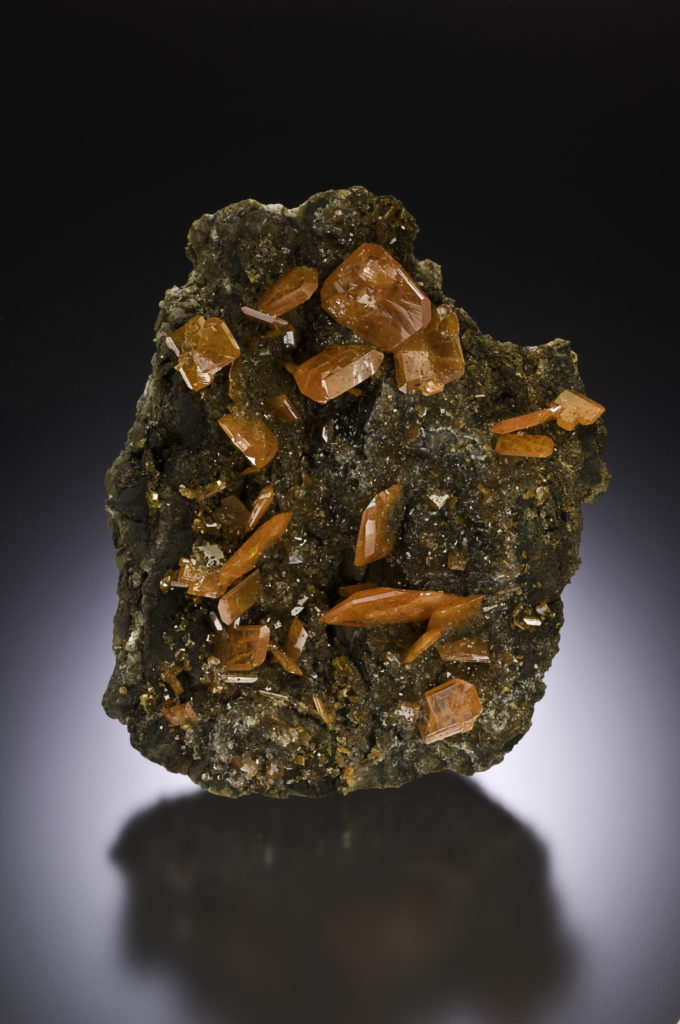
Wulfenite, Red Cloud Mine, Trigo Mountains, La Paz Co., Arizona – 10.7 cm
Les and Paula Presmyk specimen, J. Scovil photo.
Wulfenite, Red Cloud Mine, Trigo Mountains, La Paz Co., Arizona – 4.3 cm
Les and Paula Presmyk specimen, J. Scovil photo.
This was a super talk!
Just as an aside, Red Cloud has been written about a lot, given its legendary status among mineral localities. Of the many published articles and chapters in books, I particularly like the accounts in “Collecting Arizona, State of Mines, Legacy of Minerals” (recounted by Tony L. Potucek, Les Presmyk, Richard Graeme and others, edited by Terry Wallace with Gloria Staebler, Ray Grant, Suzanne Liebetrau and Tom Wilson, published by Lithographie, 2012), and I personally was originally inspired by the Red Cloud Mine section in Peter Bancroft’s classic “Gem and Crystal Treasures” (published by Western Enterprises-Mineralogical Record, 1984). These are good reads – I highly recommend them.
Sunday Finale
By Sunday morning, it was time to recover from all the orange and red crystals from Saturday afternoon.
In past years, we have sometimes had lower attendance on Sunday mornings, but again this year Sunday morning was most-hands-on-deck. (Granted a few stragglers had had too much fun Saturday night.)
Meet an Important Unknown Mineralogist
Belgian collector Herwig Pelckmans led off with a talk that was fascinating, and not only for its subject matter. In his research and work on certain minerals, Herwig had come across the name Vaes, in connection with several uncommon species, and he was curious to know who “Vaes” was. However, when he looked him up, there was almost no information readily available. And so Herwig began an extensive research investigation that led him eventually back to the family and descedants, as he learned about the mineralogist Johannes Vaes (1902-1978). Vaes was a Dutch mining engineeer who became a mineralogist in the Democratic Republic of the Congo. He worked with the company Union Miniere du Haut Katanga, and he identified and defined several new minerals.
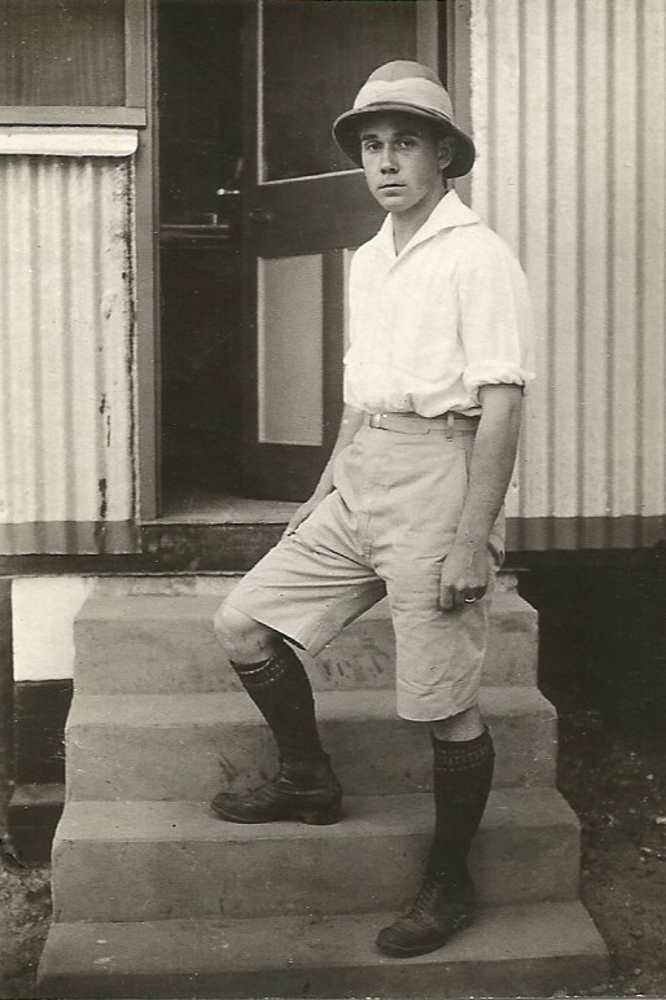 J. F. Vaes in Jadotville (now called Likasi), when he was most likely in his early thirties.
J. F. Vaes in Jadotville (now called Likasi), when he was most likely in his early thirties.
Unknown photographer. Copyright H. Pelckmans
Vaes was at the famous Shinkolobwe Mine, and it was here that he made his discoveries.
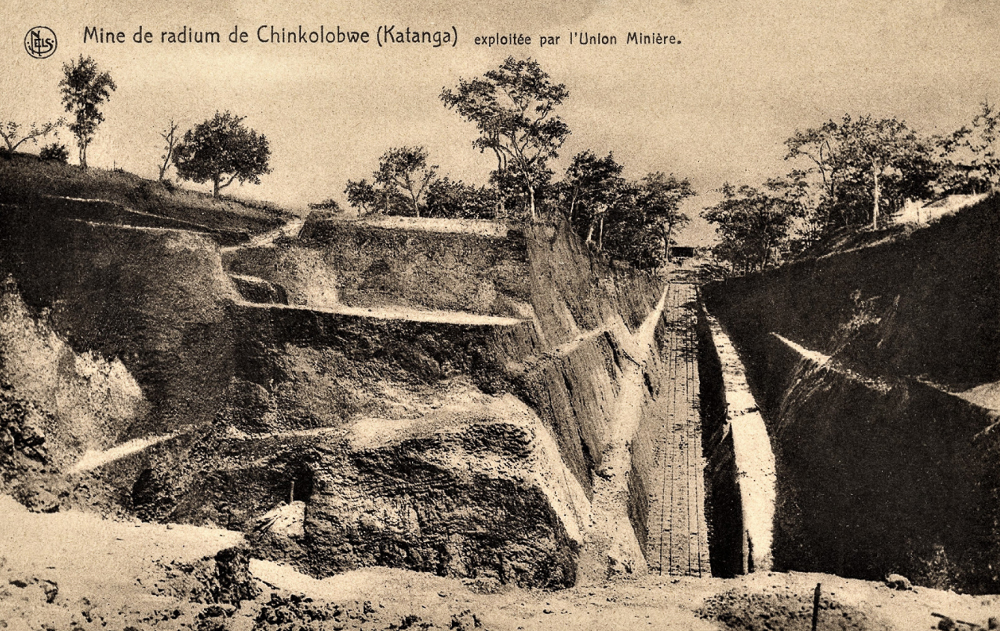
Old Belgian postcard showing the open pit of the Shinkolobwe uranium mine, printed by Nels.
Notice the original French spelling of the locality. Photo and copyright H. Pelckmans.
One striking fact about Vaes’ discoveries is that the only scientific instrument he had at his disposal was a polarizing microscope.
Saleeite, Shinkolobwe Mine, Shinkolobwe, Katanga Copper Crescent,
Katanga, Democratic Republic of the Congo
Field of view 3.6 cm
Paul De Bondt specimen and photo.
The mineral vaesite (NiS2) is named in his honour.
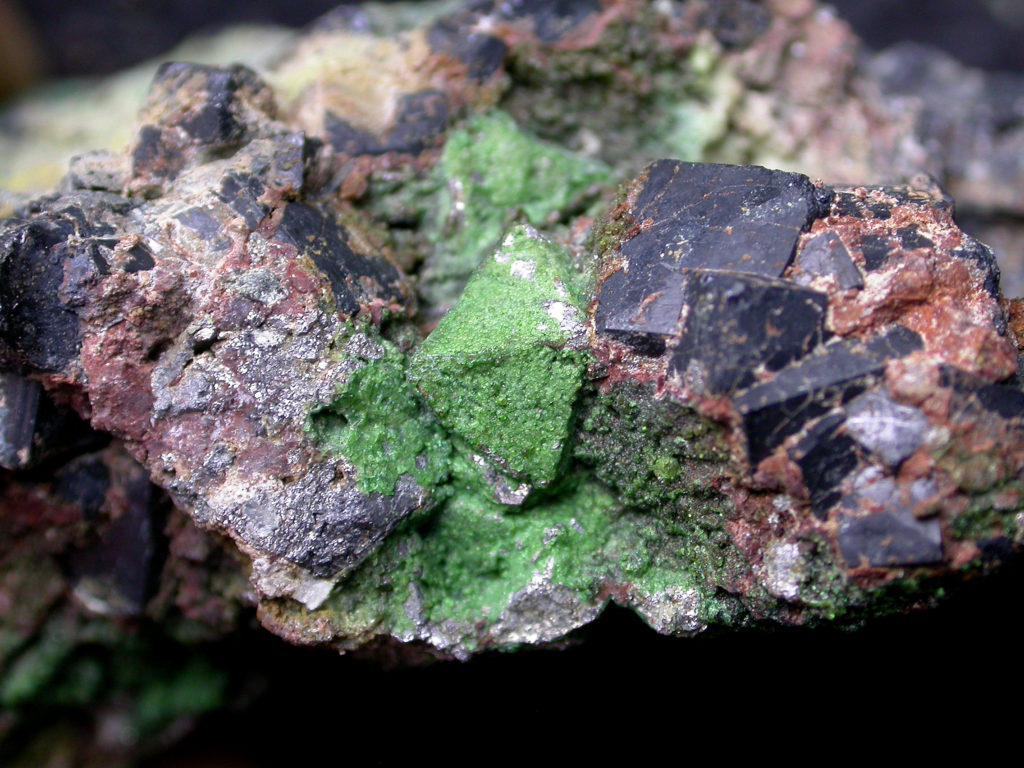
Vaesite with Nepouite coating, associated with black uraninite crystals
Shinkolobwe Mine, Shinkolobwe, Katanga Copper Crescent,
Katanga, Democratic Republic of the Congo
Field of view 3.5 cm, vaesite crystal 1.1 cm.
Paul De Bondt specimen and photo.
At the end of this talk, we had an example of one of the great things about the RMS – the amazing pool of mineral knowledge and mineral history knowledge that is collected together in that ballroom. Van King was able to add an extra footnote to the talk, giving further context for the mineral collecting community: he was able to share that Vaes had in fact been the boss of famous mineral dealer Gilbert Gauthier (who was ultimately responsible for handling many of the fine DRC specimens that now grace collections around the world).
The Pioneer District, Pinal County, Arizona – The Silver King and Magma Mines
Les Presmyk gave the final talk at RMS 2017, about the Silver King Mine and the Magma Mine in the Pioneer District. This was another excellent presentation, with detailed historical accounts and wonderful historical photos. This one really struck me – today, it is hard to imagine horse/mule-drawn ore trains.
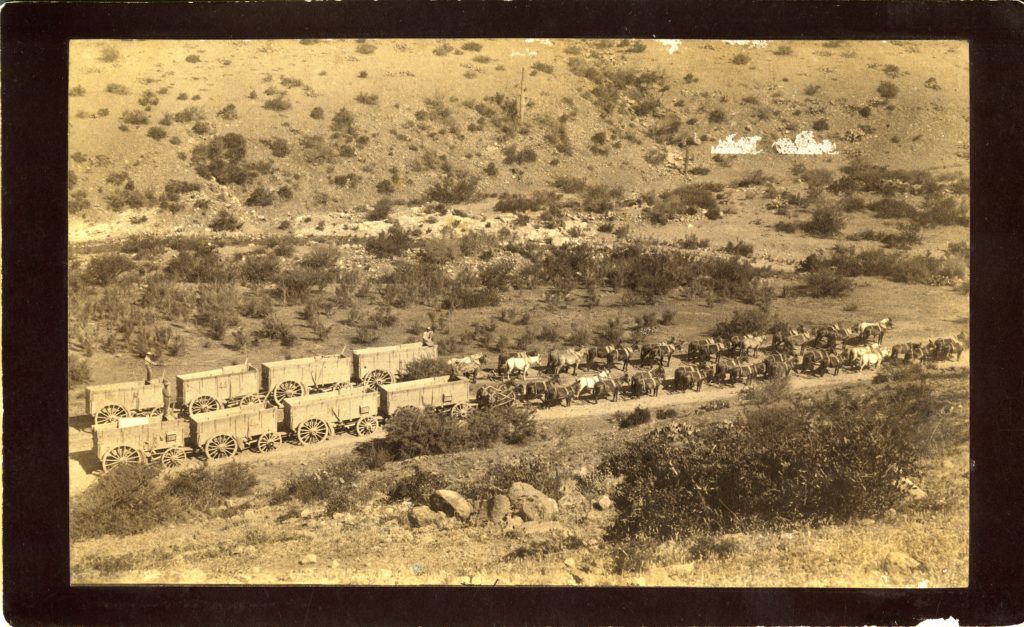
Mule-drawn ore wagons at the Silver King Mine, 1880s. AHS Photo.
This part of the talk is very well represented by Les’s recent excellent article in The Mineralogical Record, “The Arizona Silver Belt: Silver King to McMilllenville”, The Mineralogical Record July-August 2015, Vol. 46:4.
Les then spoke about the famous Magma Mine, where he had worked as a mining engineer. This mine is probably best known among collectors for the glassy barites it produced, but it also produced some wonderful calcite specimens.
Calcite, 3700 Level, 4D Stope, Magma Mine, Superior, Pinal Co., Arizona -11.1 cm
Les and Paula Presmyk specimen, J. Scovil photo.
Barite, 3600 Level, 4D Stope, Magma Mine, Superior, Pinal Co., Arizona – 7.1 cm
Les and Paula Presmyk specimen, J. Scovil photo.
The Rest of the Fun
As I write every year in my RMS posts, a lot of the best of Rochester occurs beyond the talks – in the halls, over meals, and on the 4th floor (the dealer floor, open when talks are not on). Socializing continues well into the morning hours each night, and includes a few traditions – among others, the not-to-be-missed Saturday night mineral songs with David Joyce. (I assume most have heard Dave’s mineral collecting and mining tunes, but if not, I’m including a link below).
The collegiality at the RMS is unique among mineral events!
Displays
The Exhibit Room had great displays this year, as every year. Some are contributed by museums and many are contributed by collectors attending the RMS.
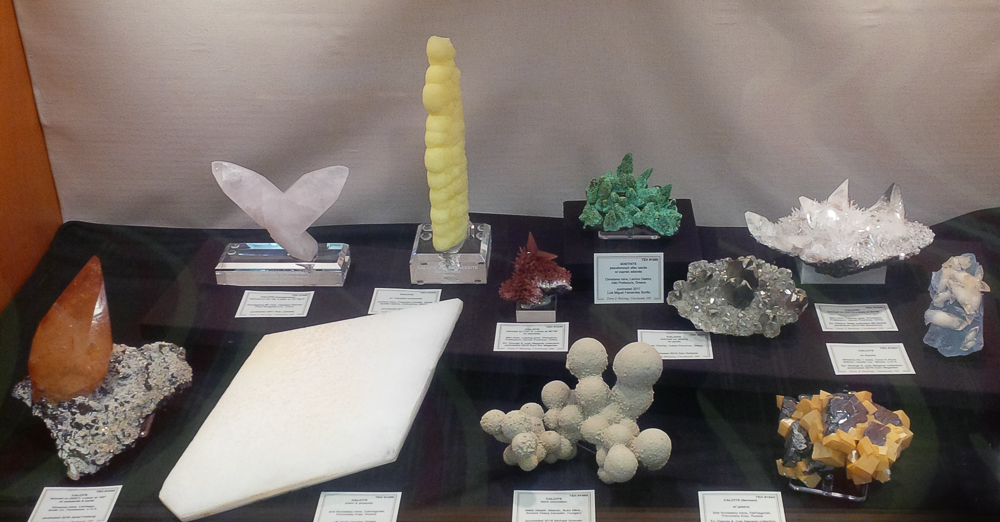
Calcite, Terry Huizing collection.
Amazing variety in this case.
As a reader, I often find it hard to take in many full-case displays in photos, so here are just a few of the specimens that really struck me.
This brilliant bournonite in John Betts’ case has truly gorgeous twinning.
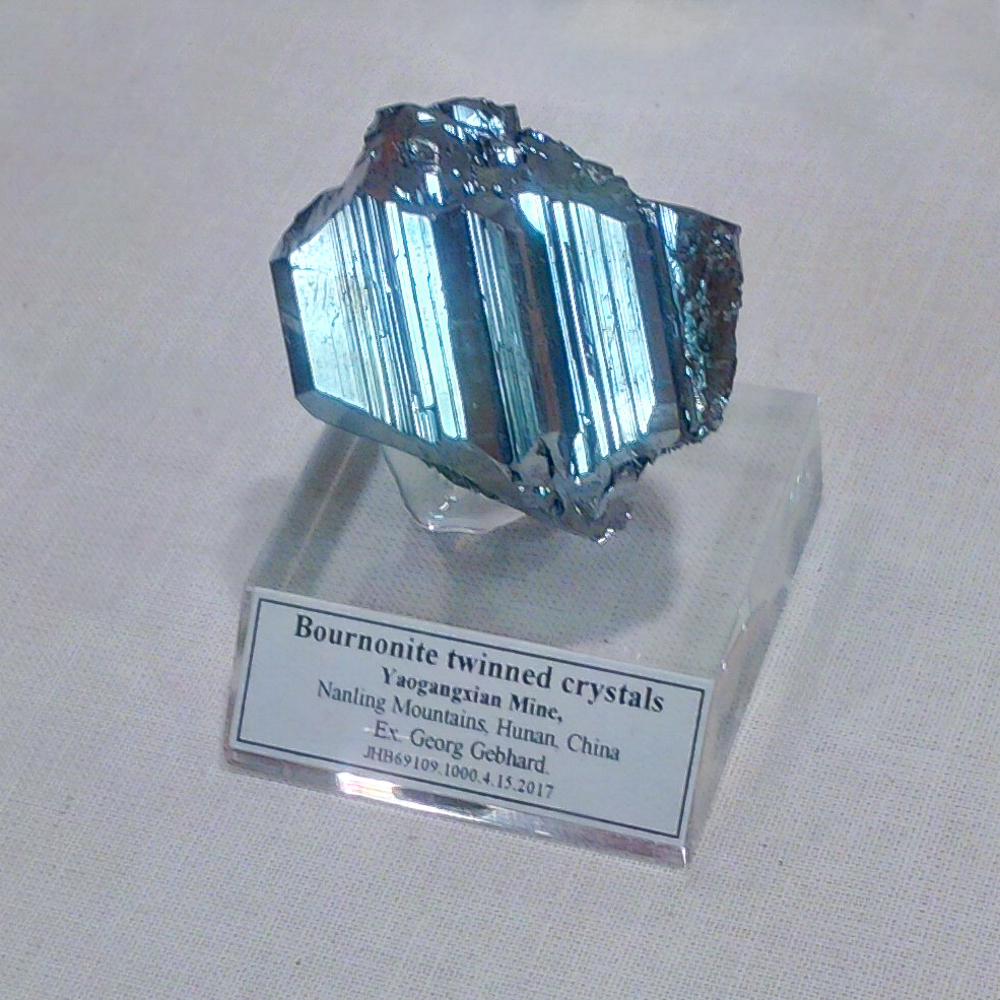
Bournonite, Yaoganxian Mine, Hunan, China – 3.6 cm
John Betts collection.
A huge spinel from the classic New York locality featured in the display from the New York State Museum.
Spinel, Monroe, Orange Co., New York – approx 15 cm
Steve Chamberlain collection at the New York State Museum.
Super quartz from Palermo No.1 – for all the world looks like a fine contemporary Brazilian quartz, with bright, glassy lustre not conveyed in the photo.
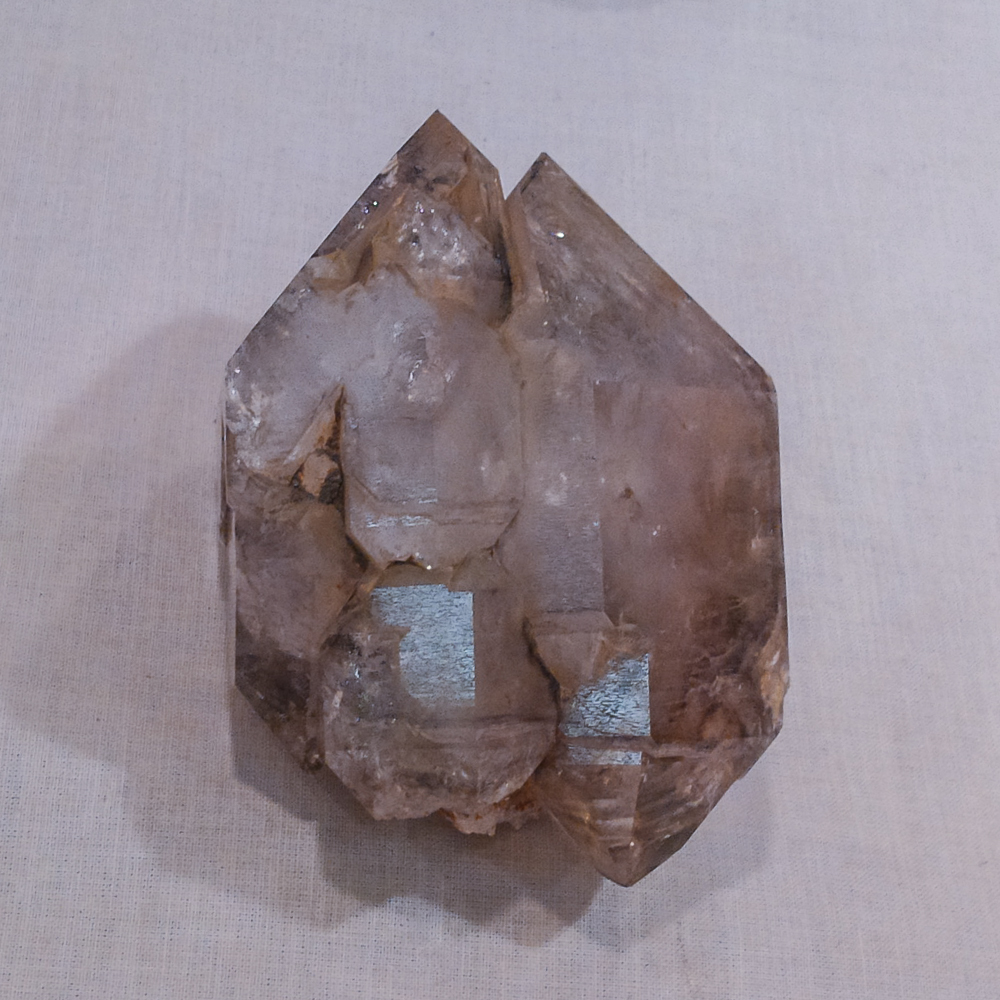
Quartz, Palermo No. 1 Mine, North Groton, New Hampshire – approx 7 cm
Mined by Bob Whitmore. Maine Mineral and Gem Museum
A great nest of silver wires from Beaverdell, in George Thompson’s case.
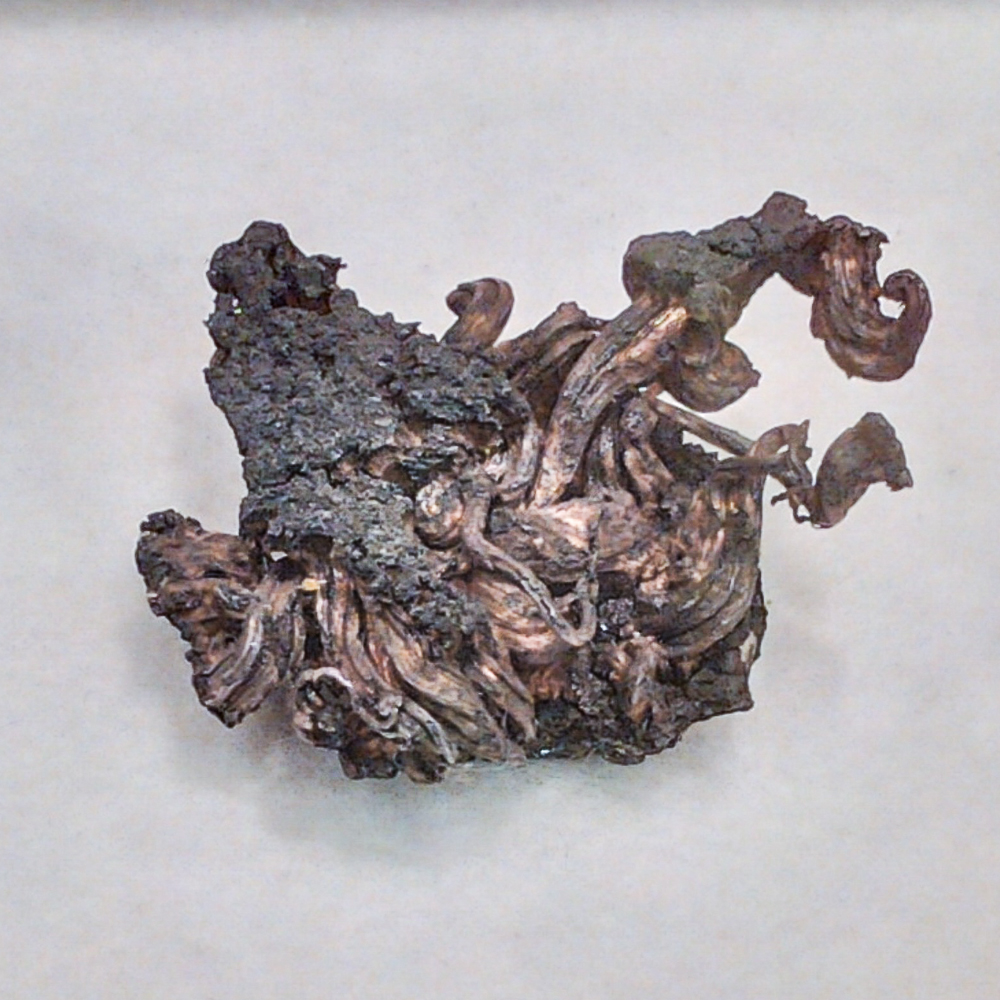
Silver, Highland Bell Mine, Beaverdell, British Columbia – approx 5 cm
George Thompson collection.
Two super specimens from John Medici’s case.
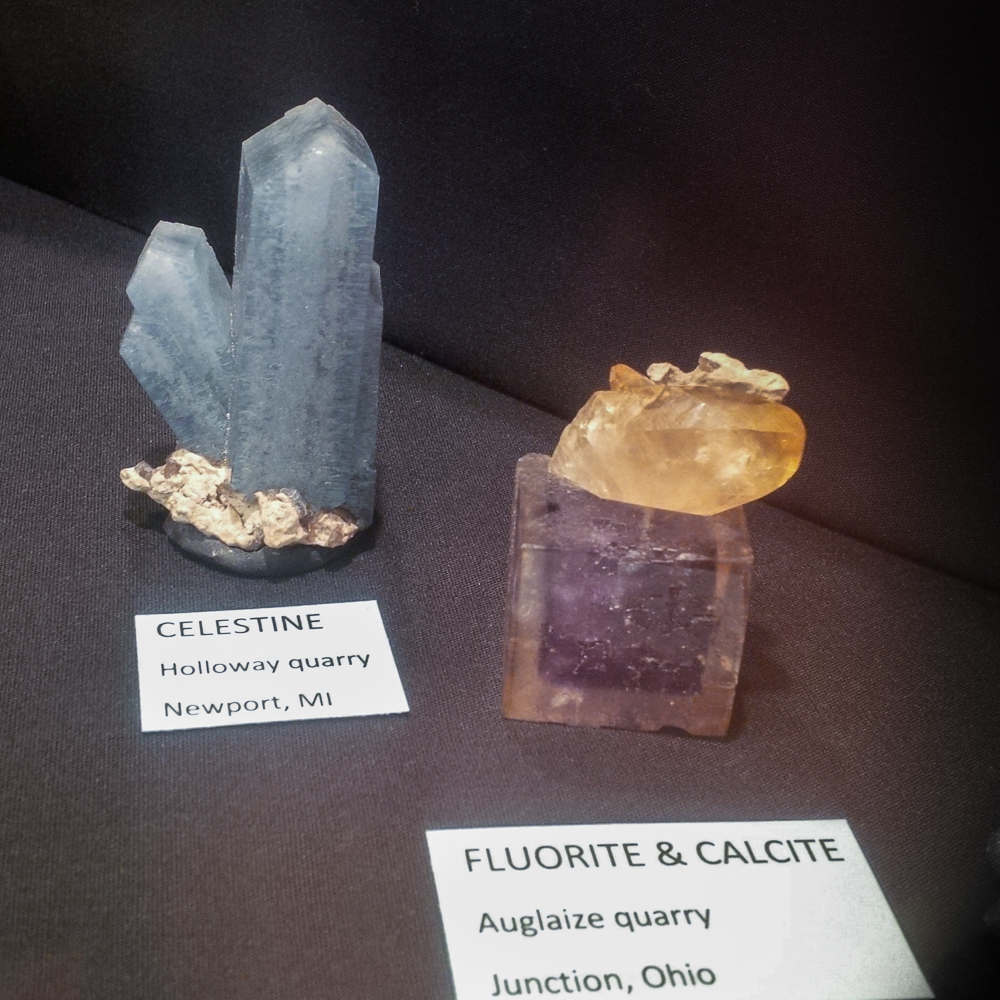
Celestine, Holloway Quarry, Newport, Michigan – approx 7 cm
Fluorite with Calcite, Auglaize Quarry, Junction, Ohio – approx 5 cm
John Medici collection.
This hematite took my breath away. It is spectacular! It was part of an excellent display case of hematite and goethite from the Diane Francis collection.
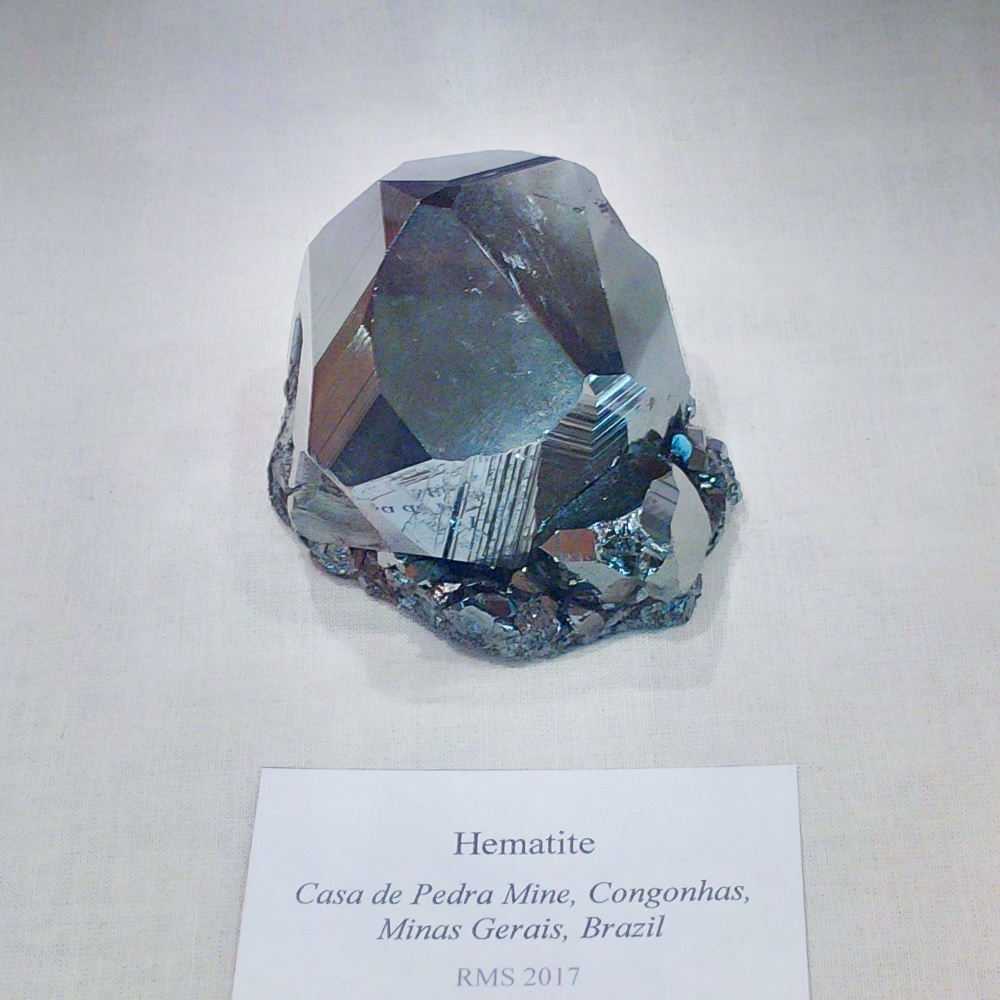
Hematite, Casa de Pedra Mine, Congonhas, Minas Gerais, Brazil – approx 7 cm
Diane Francis collection.
David Joyce had a great case of Grenville minerals. I thought rather than include something you might be expecting, like one of Dave’s great titanites, fluorapatites or zircons, I’d opt for something we don’t usually see from the Grenville. This is a striking, bright yellow sphalerite crystal.
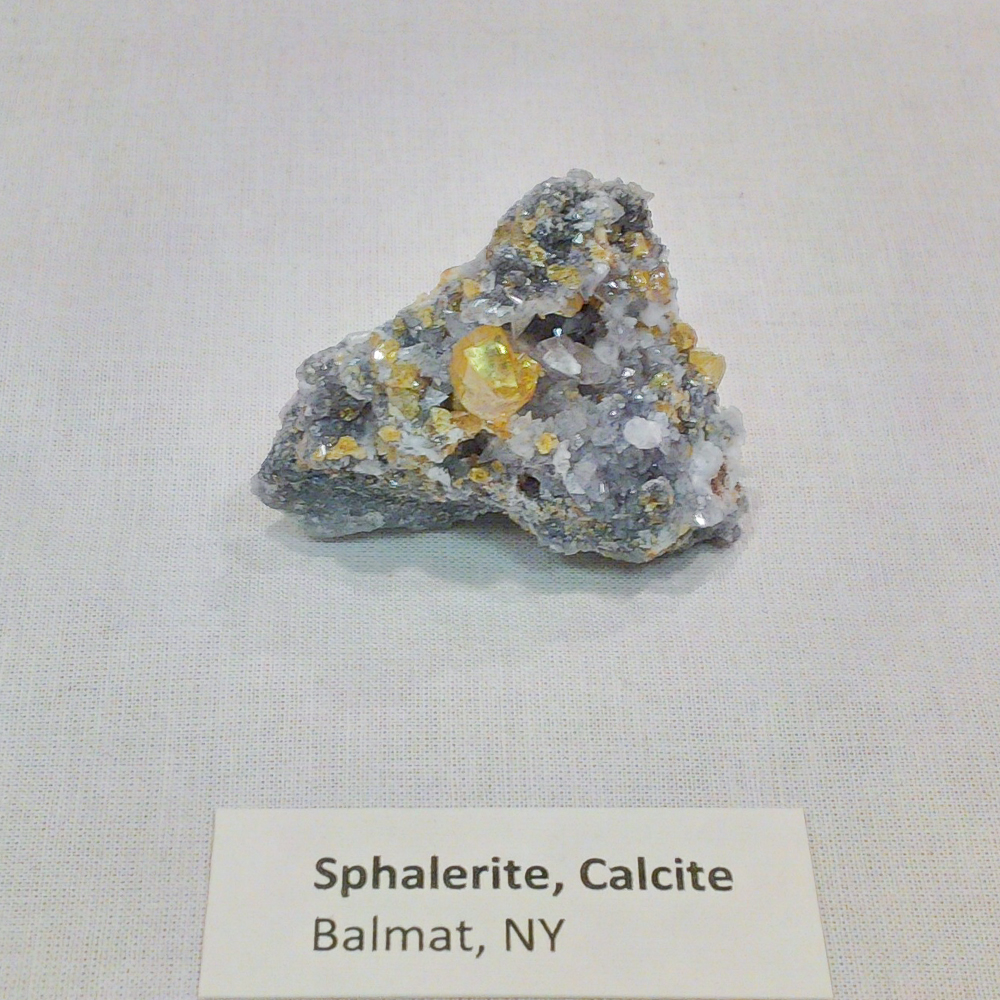
Sphalerite, Balmat, St.Lawrence Co., New York – approx 5 cm
David K. Joyce collection
This beautiful sphalerite was formerly in Bill Pinch’s collection, and he gave it to Dave as a gift, so it seemed particularly fitting to include as my last photo entry from the cases this year.
Bill Pinch
As mentioned above, the following is the full In Memoriam written by Steve Chamberlain and included at the beginning of the RMS Program Notes this year.
In Memoriam – Rochester Mineralogical Symposium
Bill Pinch passed away on April 1, 2017 from complications of earlier surgery. A reception will be held this year in Rochester, New York, to celebrate his life. Next February, there will be a memorial service in Tucson, Arizona. We will celebrate his many achievements next April at the 45th Rochester Mineralogical Symposium.
Bill was an elemental force in specimen mineralogy. One of his most significant achievements was the initiation of the Rochester Mineralogical Symposium. The First Annual Mineral Workshop was held 20-21 April 1974 at the Sheraton Inn in Canandaigua. Under the auspices of Mineral Section President, Kay Jensen, Bill and Dave Jensen served as co-chairmen this first year. The second workshop, now the Rochester Mineralogical Symposium, was held 17-20 April 1975 in the downtown Holiday Inn and was again co-chaired by Bill and Dave Jensen.
For the next ten years, Pinch served as convening co-chairman and helped build the Symposium into an internationally-recognized annual event, setting the highest standards for speakers, exhibits and congeniality. He initiated the annual What’s New in Minerals – still a popular Saturday morning part of the event. He also began the annual production of Program Notes. With the 13th RMS, formal leadership of the Symposium passed to others, but Bill continued to serve as an advisor. With his support, the Technical Session was added to the Friday afternoon program and important mineralogical works were reprinted, including Goldschmidt’s Atlas der Krystalformen and Beck’s Mineralogy of New York State, to name just a few.
At the 25th Symposium, Bill gave a keynote address, “50 Years of Mineral Collecting; 25 Years of the Symposium”. The preceding year, the Symposium had donated the annual proceeds of its annual auction to the successful funding effort for the Canadian Museum of Nature to purchase the W.W.Pinch mineral collection, establishing another legacy.
Slowly, over the next decades, Bill drifted away from direct participation in the Symposium We were delighted by his attendance at the 43rd RMS on the occasion of Michael Bainbridge’s talk, “The William W. Pinch Collection at the Canadian Museum of Nature”. The coming book of the same title will be a fitting memorial to Bill’s success in assembling a world-class mineral collection. Here we acknowledge our debt to Bill for his successful efforts in beginning and growing the Rochester Mineralogical Symposium. Godspeed.
2018 RMS
As I mentioned up top, RMS 2018 will be a little different – it will be dedicated to Bill’s memory, and it will include talks on several topics that were close to Bill’s heart – among them, Tsumeb, Rare Minerals and Fine Minerals. Stay tuned for updates, as arrangements are finalized. The dates are April 19-22 ,2018.
Until Next Year…
The Rochester Symposium is a great event, that has seen many of Mineral World’s most prominent names as contributors. At the same time, the Symposium continues to embrace contributions from all levels in mineral collecting – it simply would not be what it is without everyone who contributes.
Of course, the Symposium could literally not happen without the dedicated efforts of the team who put it together – countless thanks to Steve Chamberlain (chair), Helen Chamberlain (registrar), and many others on the committee and those helping at the event and in the background, including Dan Imel, Carl Francis, Bruce Gaber, Brian McGrath, Bob Morgan, Betty Fetter, George and Susan Robinson, Quintin Wight, Elizabeth Von Bacho and Tom White. I hope I haven’t missed anyone!
And thank you to all of the speakers and photographers from this year, for all of your help with photos to share through this report.
Links and References
If you are seeking links for anything mentioned above, some of these may be of interest:
On Bill Pinch’s website, there are tabs for the In Memoriam and also Links (this latter includes three links, with a video produced after the Canadian Museum of Nature acquired his original collection).
Our amazing professional mineral photographers (who – of course – take photos of private collection specimens for individual collectors): Jeff Scovil and Michael Bainbridge
The new book by Robert J. Lauf: Collectors’ Guide to Orthosilicates
The Adelaide Mining Company has lots more crocoite photos (mining and specimens available) on its website. The underground photos are in the History section – they really give a sense of how tight most of these pockets have been, and provides good context for how remarkably well the specimens have been collected and preserved.
David K. Joyce has written – and plays and sings, of course – the soundtrack for so many great times in minerals. The tunes are available on itunes and the CD is available from Dave – if you’d like to hear them, here is the page where you can listen.
When they are available, the 44th RMS Program Notes will be posted online here.


